Trip Report:
Rwanda's
Mountain Gorillas
Trip Report Trip Two
Our 81-85th trek
2014
Photos will appear as soon as I have a good internet connection!
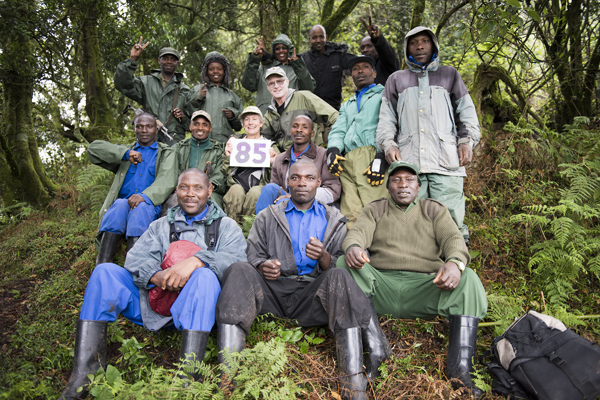
The conclusion of our 85th Trek, with the Gorilla Trackers,
our Porters, the Army guards, and our Gorilla Guide. Randy Gebhardt photo.
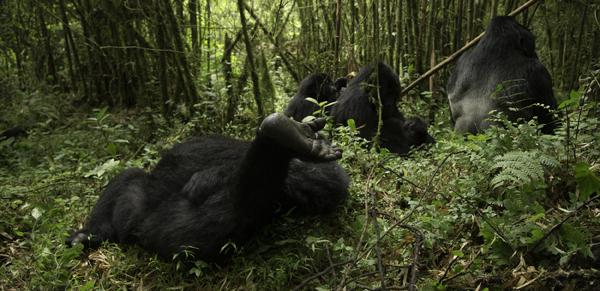
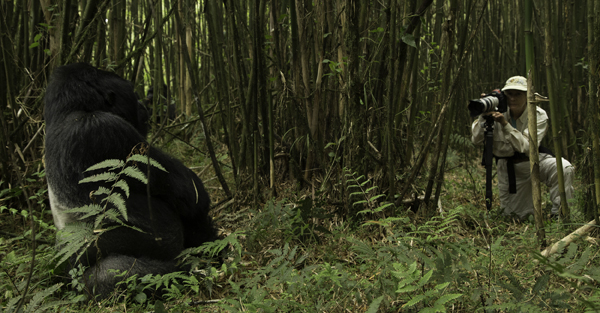
Mary with a silverback on the first day of our trek
Our second Photo Tour of the season to The Mountain Gorillas of Rwanda's Volcanoes National Park was highlighted by a wonderful celebration, hosted by the Mountain Gorilla View Lodge, in honor of 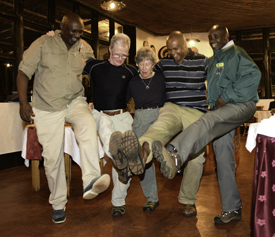 completing our 85th trek. It was a great party, filled with nice speeches, dance (yes, believe it or not), and great food.
completing our 85th trek. It was a great party, filled with nice speeches, dance (yes, believe it or not), and great food.
This trip is one of our all-time favorite locations. If you've read the trip report for our 76-80th trek you can skip down to the daily write-up. I've included the previous report's intro, however, because it does sum up how we feel about this country, the management, and the gorilla experience. If you didn't read that report, please read the following three paragraphs. We're proud to say that we've now made 85 treks, more than any other tourist to Rwanda and our visits have only been exceeded by the researchers there. While that's certainly a brag, we have no apologies here, for the experiences and photography are so spectacular, we're okay with noting this accomplishment.
Rwanda is unique among all the East African countries we've visited, as the country is almost spotlessly clean. There is no litter, and one Saturday morning each month everyone participates in a National clean-up, and the results show. Further, our tourist dollars that are spent on high gorilla visitation fees are actually being put to good use. The Park and its management is well run, superbly so, and various community projects and improvements, generated by the gorilla fees, reenforce the value of the gorillas. Since we've started visiting Rwanda the mountain gorilla population has increased by nearly 100, and as much as an endangered species can be said to be thriving, these gorillas certainly are.
In short, we love the country, and we think that the Mountain Gorillas provide one of the most intimate, exciting, and unique wildlife experiences one could find anywhere in the world.
This year everyone followed our advice to bring a monopod for our gorilla photography. Mary and I have been extremely pleased with our Really Right Stuff monopods and their pro monopod head. Although a regular ballhead can be used with a monopod, when the locking lever is loose the head, and therefore the camera and lens, can flop, which is not only awkward but can also be quite painful if the rig flops down on your finger or the web between your thumb and index finger. The 'tilt' that a ballhead allows can be easily achieved with a monopod by simply slanting the monopod, or loosening the lens mount and rotating the lens inside the collar. Either way, it works and it is very effective. We carried our gear to Rwanda in our Gura Gear Bataflae bags, which we used throughout our time in Rwanda, Tanzania, and Kenya. The bags are light weight and very water resistant, and extremely durable.
The following is the trip report, posted from Nairobi, on the day we returned back from our latest Kenya Photo Safari. Here's the Report for our 81-85th treks.
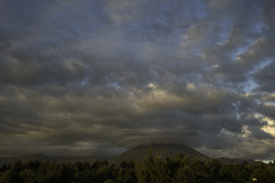
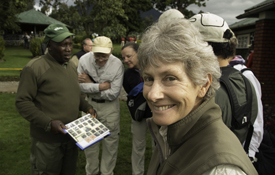
Day 1. Kilgali to Mountain Gorilla View Lodge,
Volcanoes National Park
Our group left Nairobi, enduring a lengthy traffic jam on the way to the airport. Not far from the airport our vehicle passed an industrial complex where plastic trash was piled inches deep across the lot, my last visual of Kenya before flying on to Rwanda. The flight was uneventful and we arrived on time, meeting our guide, changing money, and having a wonderful meal at the Hotel Mille Collines, the famous hotel from ‘Hotel Rwanda,’ where Tutsi refugees were harbored during the genocide. We spoke with a young woman from England who was the maître de, and who said she had just renewed her yearly contract to stay on in Rwanda. She loves it here, and said ‘in Europe, people have lost their smiles.’ And here, the people were happy and friendly. We shared her opinion.
We arrived at our lodge where we were greeted by the owner, Paul, whom we’ve known since our first visit to Rwanda 11 years ago. Our group was welcomed with drinks and snacks and Rwanda dancers, and that evening, at dinner, a great ‘welcome cake’ celebrating our return. A great start.
Day 2. Agashya Group
Check in and guide assignment went smoothly, and our group got the guide and the group we wanted. We drove quite close to our lodge for our trek, after having a false start when, upon beginning the trek, our guide received a radio call informing us that the gorillas had moved on. We drove to our new location and began the trek, hiking about 55 minutes before reaching the wall marking the Park boundary. Our guide showed us Flap-necked Chameleons, and entertained us with his demonstration of the gorillas’ food items, prompting several to share with him the Eucalyptus tree sap which they bit off with their front teeth.
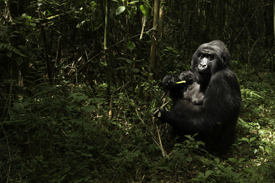
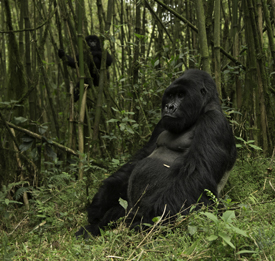
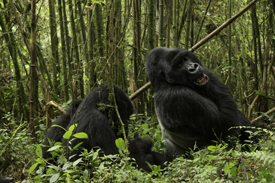 We walked less than ten minutes through the forest before meeting the gorilla trackers, in the bamboo forest not far from the wall. The gorillas were still feeding, and over the next hour we probably walked a few hundred yards as we followed them as they fed upon the bamboo. The Agashya group has one Silverback but several females and babies, and we had multiple opportunities for portraits of the silverback. The light was wonderfully even for most of the shoot, with the sun popping out for some contrasty shots for only a few minutes. Otherwise, the light was uniform, although higher ISOs were required. Looking at our shots that evening, however, they were sharp, and I converted about 20 keepers for the shoot.
We walked less than ten minutes through the forest before meeting the gorilla trackers, in the bamboo forest not far from the wall. The gorillas were still feeding, and over the next hour we probably walked a few hundred yards as we followed them as they fed upon the bamboo. The Agashya group has one Silverback but several females and babies, and we had multiple opportunities for portraits of the silverback. The light was wonderfully even for most of the shoot, with the sun popping out for some contrasty shots for only a few minutes. Otherwise, the light was uniform, although higher ISOs were required. Looking at our shots that evening, however, they were sharp, and I converted about 20 keepers for the shoot.
Day 3. Sabyinyo Group
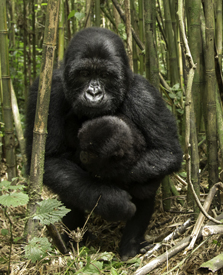
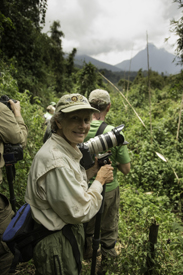
We visited our favorite group this morning/afternoon, and we earned every yard of it. The hike to the fence went through the abandoned Serena property, a stone fenced area where the hotel chain had planned to build a hotel directly adjacent to the forest and park boundary. Fortunately that was eventually denied, and now we walked through freshly hoed potato fields in neat terraces that extended below us and off into the distance, to the further hills.
Once through the stone wall we hiked nearly continuously uphill, through bamboo forest and hygena-like Dob trees, beautiful, twisted trunks that resembled live oaks from the southern US. We moved upward until we reached 8,940 feet, and then, overlooking the Congo, or entering it according to my GPS, we started back into the bamboo forest where we met our trackers.
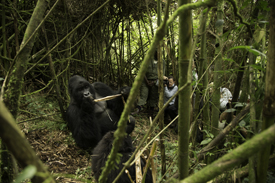 The shooting was extremely difficult, as the bamboo was dense in many places and the small, vegetation-choked clearings were narrow, making shooting very tight. Three Silverbacks are in the group, including Gahunda, the largest, who is now 44 years old, lacking canines, and nearing his end, and his two sons, the 2nd in command and a recently turned silverback, S – 3rd, who used to act quite crazy and aggressive. Now he’s relatively mellow, and has acquired his first wife from another group.
The shooting was extremely difficult, as the bamboo was dense in many places and the small, vegetation-choked clearings were narrow, making shooting very tight. Three Silverbacks are in the group, including Gahunda, the largest, who is now 44 years old, lacking canines, and nearing his end, and his two sons, the 2nd in command and a recently turned silverback, S – 3rd, who used to act quite crazy and aggressive. Now he’s relatively mellow, and has acquired his first wife from another group.
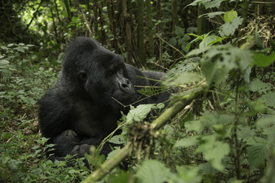 M, the 2nd, mated enthusiastically with a new female twice, both uttering their characteristic oohing notes and little chirps, and the male shook and thrust with a violence or vigor I’d not seen before. Gentle Ben, who goes by another name but is distinguished by a bald head that gives him a Jesuit Monk’s appearance, was cooperative, and posed nicely, as did a mother with baby, the mother having been born without one hand.
M, the 2nd, mated enthusiastically with a new female twice, both uttering their characteristic oohing notes and little chirps, and the male shook and thrust with a violence or vigor I’d not seen before. Gentle Ben, who goes by another name but is distinguished by a bald head that gives him a Jesuit Monk’s appearance, was cooperative, and posed nicely, as did a mother with baby, the mother having been born without one hand.
In the course of our time with the gorillas we traveled hundreds of yards, mostly downhill or across steep slopes, sometimes requiring us to duck or bend nearly in half to negotiate through bamboo tunnels. No 3 did a few hoots and charges, all downhill and away from us, grabbing bamboo poles and pulling them down as he thundered and crashed into the jungle.
We didn’t finish until nearly 12:30, pretty much exhausted from a very arduous hike and encounter. On the way back we took a short cut that cut our hiking time to only 45 minutes, in contrast to the 2 and a half hours it took to reach the gorillas. As usual, our guide performed a little celebratory gorilla dance, wrestling with one of the trackers, then jumping up and pulling down a limb, which snapped, and flung an extremely well camouflaged caterpillar onto Randy’s shirt sleeve. The caterpillar, even up close, was barely distinguishable as one, matching the goats beard lichens that festooned the broken branch it came from.
According to my GPS we had entered the Congo when we were with the gorillas, and our route took us around one of the low mountain peaks, around several calderas, and finally, back to another location where our driver/guide had negotiated a bumpy lane to meet us, about a half mile from our original departure point. We reached our lodge long after 2, and after lunch, nearly everyone took a long afternoon nap, recovering from a hard day.
Day 4. Hwira Group
We had a very brief orientation at the Park HDQ before driving up a bumpy, narrow track to our parking area. Our trek was mainly uphill, sometimes quite steep, as we ascended the farm fields, but what a view! The skies were, at that time, mostly covered in clouds, with terraced fields stretching out on all sides and below us. Sunlit shone brightly off distant tin roofs, and in the valley mist or fog or, more likely, smog from charcoal fires created row upon row of purplish ridges, and as someone said, ‘mountains in the smoke.’
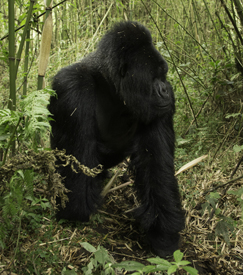
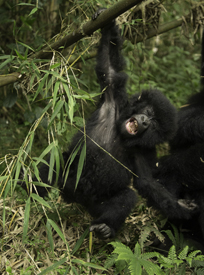
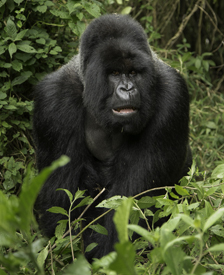
Our trek inside the forest was a fairly easy one, with some climbing before leveling off in the bamboo belt where we left our porters. While we organized our gear gorillas were moving through the bamboo towards us, and I was struck how utterly oblivious, or uncaring, the gorillas were in their forest. We moved out, and almost immediately had a female sitting in a wonderful open spot, a baby suckling in her arms. Stupidly I decided to switch cameras and mount my 70-300, rather than simply getting the shot with the 24-105, and in doing so the mother left, leaving me with nothing.
Baby action was intense today, with several babies hanging from bamboo poles and spinning before us. At one point, as almost all of us crowded into a small opening where a baby swung, and a mother sat watching close by, a silverback entered the clearing behind us and stood, on all fours, scanning the meadow before him. It was a wonderful portrait moment.


Perhaps the behavioral highlight was a female who our guide immediately identified as ‘wanting gigi-gigi,’ or desiring to mate. She approached the silverback who regally and dismissively looking away, peering over his shoulder to the bamboo above. The female approached him; he ignored her, and she grabbed some inedible ferns and stuffed them in her mouth. After a few chews she spit out the greens, and walked directly in front of the silverback, staring directly at him until he looked her way. At that point he reached out with his left arm to embrace her, and she turned to present herself. Just as they were to mount he turned her and gave us a backend view, but our guide quickly moved us to the front where we had a more appealing front-on view. Randy said, half-kiddingly, like a voyeur, but he was on the money there.
Although we chased and struggled through the bamboo for the better part of the hour, when the male settled down so did several females, and our last shots of the day included three different females, two with young babies, nursing or looking about in the shade of the bamboo forest.
Day 5. Agashya Group
Today was, by all accounts, a completely banner day. One of the best.
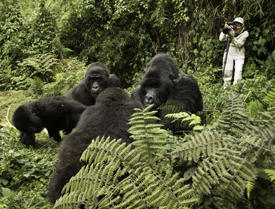 We started trekking at 7:50, hiking uphill until we were about half-way to the barrier wall. Our guide was on the radio and we turned to the east, as the gorilla family had moved. We walked through the farm fields, usually along the stone border of the park boundary, for a few minutes more than two hours. Along the way we could see the damage the gorillas had done on eucalyptus trees, tearing off bark and marking the trees with their teeth. We hoped to encounter the gorillas in the field, but somehow they kept ahead of us and all we saw was the damage.
We started trekking at 7:50, hiking uphill until we were about half-way to the barrier wall. Our guide was on the radio and we turned to the east, as the gorilla family had moved. We walked through the farm fields, usually along the stone border of the park boundary, for a few minutes more than two hours. Along the way we could see the damage the gorillas had done on eucalyptus trees, tearing off bark and marking the trees with their teeth. We hoped to encounter the gorillas in the field, but somehow they kept ahead of us and all we saw was the damage.
After two hours we were adjacent to the dense, black shadows of a 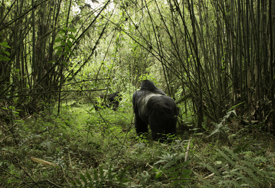 bamboo forest, and here is where we entered, climbing an extremely steep incline for about 400 feet. We had hiked all morning under heavy overcast skies, and throughout the previous night it had rained, and now, as we moved uphill I worried that we’d be caught in a downpour in a bamboo forest, the worse of all conditions. It was not to be.
bamboo forest, and here is where we entered, climbing an extremely steep incline for about 400 feet. We had hiked all morning under heavy overcast skies, and throughout the previous night it had rained, and now, as we moved uphill I worried that we’d be caught in a downpour in a bamboo forest, the worse of all conditions. It was not to be.
Instead, we found our first gorillas in an open glade, where two gorillas were parked on day beds made at our eye level. While we filmed that, a large Black-back emerged from the forest and rushed by Doug, clipping him at the knees and spilling him down the hill. He wasn’t hurt, and while he was recovering I shot a couple of frames of the blackback in the distance, strutting in the opening.
Remarkably, soon after, the same blackback climbed on to a mound where for the next ten minutes he posed magnificently, first sitting, then lying down, facing us, and offering regal poses. Other gorillas popped into our clearing and passed on, and eventually so did the blackback. We moved uphill looking for more subjects, and through the next number of minutes filmed the silverback, a female with a baby, and lone individuals.
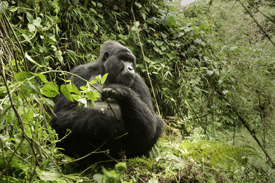
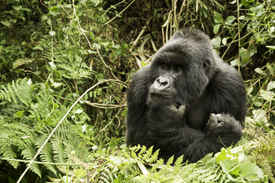
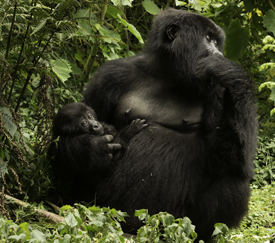
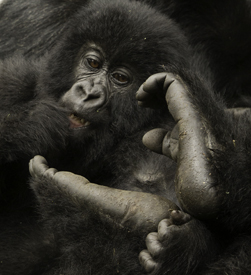
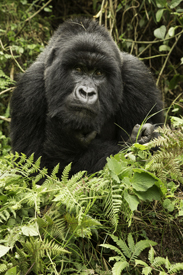 Towards the end of the hour we followed the group into a clearing where the silverback, two females with small babies, some subadults, and juveniles all lounged about or played. The light was perfect, and the shooting intense. It was a spectacular conclusion to a great shoot.
Towards the end of the hour we followed the group into a clearing where the silverback, two females with small babies, some subadults, and juveniles all lounged about or played. The light was perfect, and the shooting intense. It was a spectacular conclusion to a great shoot.
On the way back to the lodge our group stopped for some shopping, while Mary, Randy, and I visited our friend Gilbert who used to work at our former lodge, the Gorilla Nest. Gilbert lost his job when the lodge burned down, but a generous American fronted him the money to enable Gilbert to build a small rest house/lodge of his own. We were so happy to see a former assistant manager now become a property owner and owner of his own facility, Villa Gorilla. When we asked him how he gets his business, he said that Trip Advisor has done wonders for him. Patrons have great experiences and write about it on Trip Advisor, and he gets his bookings in that way. Randy, one of our participants, sponsors some former orphans and he is making a connection with one who now owns a car and takes people on local tours. He, and Gilbert, might be able to form some sort of partnership. For those on a budget, we couldn’t recommend the hospitality of Gilbert highly enough. Check out his website, www.villagorillarwanda.com or email him at info@villagorilllarwanda.com.
That evening, the management of our hotel, the Mountain Gorilla View Lodge, threw a surprise party for our group marking our 85th trek, which will occur tomorrow. Local officials, park staff, and employees attended, with radio and TV coverage, and everyone gave speeches before the presentation of a cake and gifts, and then the dancing began. It was a wonderful time, and it was great to see the appreciation everyone had for our tourist support and, more importantly, for Mary and I to express our gratitude, appreciation, and love for this country and for the incredible job Rwanda has done for protecting the mountain gorilla.
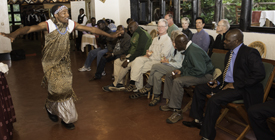
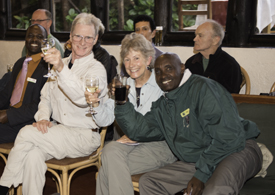
ALL PARTY PHOTOS BY RANDY GEBHARDT
A Rwandan dancer entertains the group; Joe, Mary, and our guide Alex celebrating.
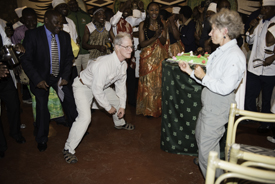
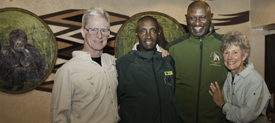
Mary and I cutting the cake and performing 'kachaa! - cut the cake or eat it, or whatever; the two of us with Alex and our host, Paul.
In contrast to many countries where a natural resource is exploited and eventually ruined, and Kenya’s Masai Mara is the prime example here, Rwanda has really demonstrated vision. The mountain gorillas are an international treasure, with Rwanda being the steward, and they have done a great job. Tourist dollars, instead of ruining the country by more and more development, has, instead, created jobs, infrastructure, education, health, and more for the local people, and protection for the gorillas, who are increasing in numbers.
Mary and I had our own opportunity to express some of these thoughts in our little speeches to the group, and it was simply wonderful to see the support and appreciation everyone had for tourism. It was a spectacular ending to a great day, and I can’t even imagine what they’ll have planned when we reach our landmark 100th trek in two years. It should be fun!
Day 6. Hirwa Group
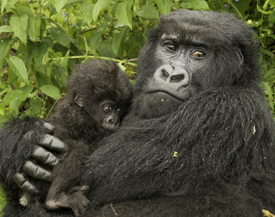 We awoke to heavy overcast skies and periodic drizzles, which continued at the HDQ as we were assigned our guide. Our drive took us in the same direction as we’d traveled the last two days, and as we started our hike up through the farm fields it began to rain. Most of us put on rain gear and slogged along.
We awoke to heavy overcast skies and periodic drizzles, which continued at the HDQ as we were assigned our guide. Our drive took us in the same direction as we’d traveled the last two days, and as we started our hike up through the farm fields it began to rain. Most of us put on rain gear and slogged along.
At the wall we entered the bamboo forest and climbed the muddy, slick trails for about 400 feet. As we progressed we could see a discernible difference in the light levels and the rain seemed to be slowing. When we reached the trackers the rain had almost stopped, and I packed my rain jacket in my sling pack, just in case.
We moved through a small stand of bamboo and met the Hirwa group, sitting in the open. The silverback was on the slope above us, and he began to make soft, gentle-sounding ‘oooh-oooh-ooh’ notes, that belied what was about to occur. The silverback was pursing his lips when doing so, a sure sign that he’s about to stand, charge, and beat his chest. I struggled to get my 24-105 out in time, and just managed to extract it as the silverback rose and beat his chest. He repeated the display a second time, when our guide directed us to move forward. At that moment he charged again, running passed where I’d have been, and all I caught was the backend of the silverback as he thumped his chest. Mary was still in position, and hopefully caught the display in focus – she had it framed!
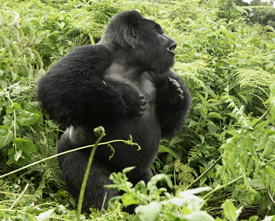
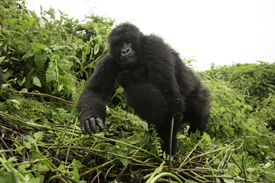
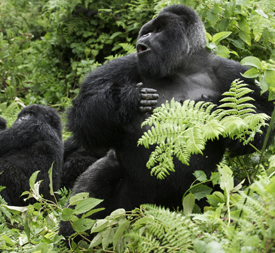 As the silverback ran by he grabbed a female and sent her spinning, as she rolled down the hill, landing on her back. I worried that he might charge by again, and do the same with one of us. He did not, and although he did the ‘oohing’ notes, and beat his chest once, but running the opposite way, he was finished. We’re fairly sure he saw, heard, or smelled a rival group in the clearings below us, and was worked up accordingly. Apparently the threat left, and he relaxed.
As the silverback ran by he grabbed a female and sent her spinning, as she rolled down the hill, landing on her back. I worried that he might charge by again, and do the same with one of us. He did not, and although he did the ‘oohing’ notes, and beat his chest once, but running the opposite way, he was finished. We’re fairly sure he saw, heard, or smelled a rival group in the clearings below us, and was worked up accordingly. Apparently the threat left, and he relaxed.
The weather improved and we had wonderful, soft light, with the silverback sitting, then stretching out in front of us, with the Rwanda valleys and farm fields stretching into the distance where they vanished in the hanging mists. Several females with small babies nursed or groomed their babies quite close, and for once I was in a position for getting good mother and baby shots. The best female turned a few times to give our entire semi-circle great views, so everyone got great shots.
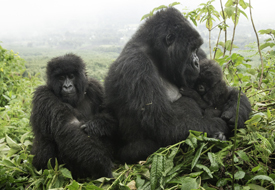
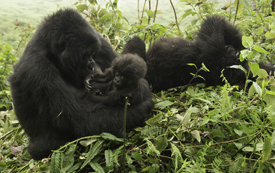
The hour simply raced by, and we concluded the shoot with a mother and slightly older baby that amused everyone with his adopting a ‘silverback stance,’ planting his forelegs firmly and stiffly, before standing and falling over on to his back. A female with a small baby sat on a hummock of vegetation, and groomed, with views of the fields, and was extremely relaxed. As our hour ended a heavy mist began rolling in, and the two females stood and walked off to join the male, in the growing gray gloom of mist and an approaching rain.
We hiked back to the vehicle in a light rain, which ended, fortunately, as we packed our vehicles for the ride back to Kilgali. Along the way we stopped in Musanze so that I could buy cheap gym shoes to satisfy the control-freak at the Serena’s gym in Nairobi, while Nancy bought a duffle to accommodate her souvenirs. Our drive back included a few stops for landscape shots, where at one tornado-like skies blackened the northern horizon, generating winds that shook the trees and our vehicle. We arrived in Kilgali by 5, tired but fulfilled by a great trip.
That evening we had a wonderful dinner with the owner of the tour company we use, at a local restaurant specializing in, among other things, some native dishes. Our starter were dried fish, sardine-size, complete with heads and eyeballs, and probably all their internal organs, too, which tasted great -- although only a few of us tried them. The rest of the meal was fairly traditional, skewers of meat, potatos, etc., and it was a wonderful way to conclude our time in Rwanda, preparing for the flight home tomorrow.
Day 7. Our arrival in Nairobi was rather humorous. Because of the Ebola scare, after we exited our jet we waited in a loose, bustling line in a narrow hall to have a self-reported Health report reviewed, and our temperature checked. Nearly half the plane's passengers were sticking out onto the outside tarmac, and with huge puddles everywhere I wondered what would happen if it began to rain. Nothing, probably, and everyone outside would have been soaked. Fortunately, it did not rain.
As Randy observed, if anyone actually had Ebola everyone in the hall would have caught it, as the conditions were crowded and congested. For those who had not previously filled out the form, they were directed to do so at some shelves lining the wall. Again, if anyone were sick, anyone following them would have picked up the virus. A group of Orientals, either Chinese or Korean, were pulled off to the side, as one in their group had a nose bleed, which triggered an alert. Of course, no one else, fortunately, was inconvenienced.
The entire exercise was a farce, but added an hour to going through the airport where our luggage waited. After experiencing the cleaniness and litter-free environment of Rwanda, I took special note as we drove back into the city, watching for the first signs of litter. Four minutes into our drive I saw the first discarded bottles, plastic bags hanging from trees, flopping in the wind, and lumps of cardboard. When I mentioned that later, Anne said I wasn't looking, she'd noticed garbage almost immediately.
I only mention this negative point because national leadership and a national pride could turn this situation around, as it did in Rwanda. I don't remember what it was like 11 years ago in Rwanda, but I suspect, back then, when plastic bags were commonly used, the problem was probably similar. Then plastic bags were banned, and the clean-up days started, and a whole new ethos began, and we have the clean country of Rwanda of today. Kenya could do the same.
We will be doing our 86-90th mountain gorilla trek between our Kenya safaris in 2015, approximately the first week in November. The experience is fantastic, and I hope you'll be able to join us. It truly is a life-changing experience. If you are interested, contact us IMMEDIATELY.
.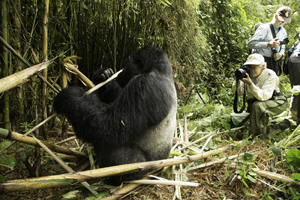
Refer to our BROCHURE to get an idea of next year's trip! The brochure is not updated for 2015 (remember, I'm in Africa), but the itinerary will be similar.
Trip Report:
Rwanda's
Mountain Gorillas
Trip Report Trip Two
Our 81-85th trek
2014
Photos will appear as soon as I have a good internet connection!

The conclusion of our 85th Trek, with the Gorilla Trackers,
our Porters, the Army guards, and our Gorilla Guide. Randy Gebhardt photo.


Mary with a silverback on the first day of our trek
Our second Photo Tour of the season to The Mountain Gorillas of Rwanda's Volcanoes National Park was highlighted by a wonderful celebration, hosted by the Mountain Gorilla View Lodge, in honor of  completing our 85th trek. It was a great party, filled with nice speeches, dance (yes, believe it or not), and great food.
completing our 85th trek. It was a great party, filled with nice speeches, dance (yes, believe it or not), and great food.
This trip is one of our all-time favorite locations. If you've read the trip report for our 76-80th trek you can skip down to the daily write-up. I've included the previous report's intro, however, because it does sum up how we feel about this country, the management, and the gorilla experience. If you didn't read that report, please read the following three paragraphs. We're proud to say that we've now made 85 treks, more than any other tourist to Rwanda and our visits have only been exceeded by the researchers there. While that's certainly a brag, we have no apologies here, for the experiences and photography are so spectacular, we're okay with noting this accomplishment.
Rwanda is unique among all the East African countries we've visited, as the country is almost spotlessly clean. There is no litter, and one Saturday morning each month everyone participates in a National clean-up, and the results show. Further, our tourist dollars that are spent on high gorilla visitation fees are actually being put to good use. The Park and its management is well run, superbly so, and various community projects and improvements, generated by the gorilla fees, reenforce the value of the gorillas. Since we've started visiting Rwanda the mountain gorilla population has increased by nearly 100, and as much as an endangered species can be said to be thriving, these gorillas certainly are.
In short, we love the country, and we think that the Mountain Gorillas provide one of the most intimate, exciting, and unique wildlife experiences one could find anywhere in the world.
This year everyone followed our advice to bring a monopod for our gorilla photography. Mary and I have been extremely pleased with our Really Right Stuff monopods and their pro monopod head. Although a regular ballhead can be used with a monopod, when the locking lever is loose the head, and therefore the camera and lens, can flop, which is not only awkward but can also be quite painful if the rig flops down on your finger or the web between your thumb and index finger. The 'tilt' that a ballhead allows can be easily achieved with a monopod by simply slanting the monopod, or loosening the lens mount and rotating the lens inside the collar. Either way, it works and it is very effective. We carried our gear to Rwanda in our Gura Gear Bataflae bags, which we used throughout our time in Rwanda, Tanzania, and Kenya. The bags are light weight and very water resistant, and extremely durable.
The following is the trip report, posted from Nairobi, on the day we returned back from our latest Kenya Photo Safari. Here's the Report for our 81-85th treks.


Day 1. Kilgali to Mountain Gorilla View Lodge,
Volcanoes National Park
Our group left Nairobi, enduring a lengthy traffic jam on the way to the airport. Not far from the airport our vehicle passed an industrial complex where plastic trash was piled inches deep across the lot, my last visual of Kenya before flying on to Rwanda. The flight was uneventful and we arrived on time, meeting our guide, changing money, and having a wonderful meal at the Hotel Mille Collines, the famous hotel from ‘Hotel Rwanda,’ where Tutsi refugees were harbored during the genocide. We spoke with a young woman from England who was the maître de, and who said she had just renewed her yearly contract to stay on in Rwanda. She loves it here, and said ‘in Europe, people have lost their smiles.’ And here, the people were happy and friendly. We shared her opinion.
We arrived at our lodge where we were greeted by the owner, Paul, whom we’ve known since our first visit to Rwanda 11 years ago. Our group was welcomed with drinks and snacks and Rwanda dancers, and that evening, at dinner, a great ‘welcome cake’ celebrating our return. A great start.
Day 2. Agashya Group
Check in and guide assignment went smoothly, and our group got the guide and the group we wanted. We drove quite close to our lodge for our trek, after having a false start when, upon beginning the trek, our guide received a radio call informing us that the gorillas had moved on. We drove to our new location and began the trek, hiking about 55 minutes before reaching the wall marking the Park boundary. Our guide showed us Flap-necked Chameleons, and entertained us with his demonstration of the gorillas’ food items, prompting several to share with him the Eucalyptus tree sap which they bit off with their front teeth.


 We walked less than ten minutes through the forest before meeting the gorilla trackers, in the bamboo forest not far from the wall. The gorillas were still feeding, and over the next hour we probably walked a few hundred yards as we followed them as they fed upon the bamboo. The Agashya group has one Silverback but several females and babies, and we had multiple opportunities for portraits of the silverback. The light was wonderfully even for most of the shoot, with the sun popping out for some contrasty shots for only a few minutes. Otherwise, the light was uniform, although higher ISOs were required. Looking at our shots that evening, however, they were sharp, and I converted about 20 keepers for the shoot.
We walked less than ten minutes through the forest before meeting the gorilla trackers, in the bamboo forest not far from the wall. The gorillas were still feeding, and over the next hour we probably walked a few hundred yards as we followed them as they fed upon the bamboo. The Agashya group has one Silverback but several females and babies, and we had multiple opportunities for portraits of the silverback. The light was wonderfully even for most of the shoot, with the sun popping out for some contrasty shots for only a few minutes. Otherwise, the light was uniform, although higher ISOs were required. Looking at our shots that evening, however, they were sharp, and I converted about 20 keepers for the shoot.
Day 3. Sabyinyo Group


We visited our favorite group this morning/afternoon, and we earned every yard of it. The hike to the fence went through the abandoned Serena property, a stone fenced area where the hotel chain had planned to build a hotel directly adjacent to the forest and park boundary. Fortunately that was eventually denied, and now we walked through freshly hoed potato fields in neat terraces that extended below us and off into the distance, to the further hills.
Once through the stone wall we hiked nearly continuously uphill, through bamboo forest and hygena-like Dob trees, beautiful, twisted trunks that resembled live oaks from the southern US. We moved upward until we reached 8,940 feet, and then, overlooking the Congo, or entering it according to my GPS, we started back into the bamboo forest where we met our trackers.
 The shooting was extremely difficult, as the bamboo was dense in many places and the small, vegetation-choked clearings were narrow, making shooting very tight. Three Silverbacks are in the group, including Gahunda, the largest, who is now 44 years old, lacking canines, and nearing his end, and his two sons, the 2nd in command and a recently turned silverback, S – 3rd, who used to act quite crazy and aggressive. Now he’s relatively mellow, and has acquired his first wife from another group.
The shooting was extremely difficult, as the bamboo was dense in many places and the small, vegetation-choked clearings were narrow, making shooting very tight. Three Silverbacks are in the group, including Gahunda, the largest, who is now 44 years old, lacking canines, and nearing his end, and his two sons, the 2nd in command and a recently turned silverback, S – 3rd, who used to act quite crazy and aggressive. Now he’s relatively mellow, and has acquired his first wife from another group.
 M, the 2nd, mated enthusiastically with a new female twice, both uttering their characteristic oohing notes and little chirps, and the male shook and thrust with a violence or vigor I’d not seen before. Gentle Ben, who goes by another name but is distinguished by a bald head that gives him a Jesuit Monk’s appearance, was cooperative, and posed nicely, as did a mother with baby, the mother having been born without one hand.
M, the 2nd, mated enthusiastically with a new female twice, both uttering their characteristic oohing notes and little chirps, and the male shook and thrust with a violence or vigor I’d not seen before. Gentle Ben, who goes by another name but is distinguished by a bald head that gives him a Jesuit Monk’s appearance, was cooperative, and posed nicely, as did a mother with baby, the mother having been born without one hand.
In the course of our time with the gorillas we traveled hundreds of yards, mostly downhill or across steep slopes, sometimes requiring us to duck or bend nearly in half to negotiate through bamboo tunnels. No 3 did a few hoots and charges, all downhill and away from us, grabbing bamboo poles and pulling them down as he thundered and crashed into the jungle.
We didn’t finish until nearly 12:30, pretty much exhausted from a very arduous hike and encounter. On the way back we took a short cut that cut our hiking time to only 45 minutes, in contrast to the 2 and a half hours it took to reach the gorillas. As usual, our guide performed a little celebratory gorilla dance, wrestling with one of the trackers, then jumping up and pulling down a limb, which snapped, and flung an extremely well camouflaged caterpillar onto Randy’s shirt sleeve. The caterpillar, even up close, was barely distinguishable as one, matching the goats beard lichens that festooned the broken branch it came from.
According to my GPS we had entered the Congo when we were with the gorillas, and our route took us around one of the low mountain peaks, around several calderas, and finally, back to another location where our driver/guide had negotiated a bumpy lane to meet us, about a half mile from our original departure point. We reached our lodge long after 2, and after lunch, nearly everyone took a long afternoon nap, recovering from a hard day.
Day 4. Hwira Group
We had a very brief orientation at the Park HDQ before driving up a bumpy, narrow track to our parking area. Our trek was mainly uphill, sometimes quite steep, as we ascended the farm fields, but what a view! The skies were, at that time, mostly covered in clouds, with terraced fields stretching out on all sides and below us. Sunlit shone brightly off distant tin roofs, and in the valley mist or fog or, more likely, smog from charcoal fires created row upon row of purplish ridges, and as someone said, ‘mountains in the smoke.’



Our trek inside the forest was a fairly easy one, with some climbing before leveling off in the bamboo belt where we left our porters. While we organized our gear gorillas were moving through the bamboo towards us, and I was struck how utterly oblivious, or uncaring, the gorillas were in their forest. We moved out, and almost immediately had a female sitting in a wonderful open spot, a baby suckling in her arms. Stupidly I decided to switch cameras and mount my 70-300, rather than simply getting the shot with the 24-105, and in doing so the mother left, leaving me with nothing.
Baby action was intense today, with several babies hanging from bamboo poles and spinning before us. At one point, as almost all of us crowded into a small opening where a baby swung, and a mother sat watching close by, a silverback entered the clearing behind us and stood, on all fours, scanning the meadow before him. It was a wonderful portrait moment.


Perhaps the behavioral highlight was a female who our guide immediately identified as ‘wanting gigi-gigi,’ or desiring to mate. She approached the silverback who regally and dismissively looking away, peering over his shoulder to the bamboo above. The female approached him; he ignored her, and she grabbed some inedible ferns and stuffed them in her mouth. After a few chews she spit out the greens, and walked directly in front of the silverback, staring directly at him until he looked her way. At that point he reached out with his left arm to embrace her, and she turned to present herself. Just as they were to mount he turned her and gave us a backend view, but our guide quickly moved us to the front where we had a more appealing front-on view. Randy said, half-kiddingly, like a voyeur, but he was on the money there.
Although we chased and struggled through the bamboo for the better part of the hour, when the male settled down so did several females, and our last shots of the day included three different females, two with young babies, nursing or looking about in the shade of the bamboo forest.
Day 5. Agashya Group
Today was, by all accounts, a completely banner day. One of the best.
 We started trekking at 7:50, hiking uphill until we were about half-way to the barrier wall. Our guide was on the radio and we turned to the east, as the gorilla family had moved. We walked through the farm fields, usually along the stone border of the park boundary, for a few minutes more than two hours. Along the way we could see the damage the gorillas had done on eucalyptus trees, tearing off bark and marking the trees with their teeth. We hoped to encounter the gorillas in the field, but somehow they kept ahead of us and all we saw was the damage.
We started trekking at 7:50, hiking uphill until we were about half-way to the barrier wall. Our guide was on the radio and we turned to the east, as the gorilla family had moved. We walked through the farm fields, usually along the stone border of the park boundary, for a few minutes more than two hours. Along the way we could see the damage the gorillas had done on eucalyptus trees, tearing off bark and marking the trees with their teeth. We hoped to encounter the gorillas in the field, but somehow they kept ahead of us and all we saw was the damage.
After two hours we were adjacent to the dense, black shadows of a  bamboo forest, and here is where we entered, climbing an extremely steep incline for about 400 feet. We had hiked all morning under heavy overcast skies, and throughout the previous night it had rained, and now, as we moved uphill I worried that we’d be caught in a downpour in a bamboo forest, the worse of all conditions. It was not to be.
bamboo forest, and here is where we entered, climbing an extremely steep incline for about 400 feet. We had hiked all morning under heavy overcast skies, and throughout the previous night it had rained, and now, as we moved uphill I worried that we’d be caught in a downpour in a bamboo forest, the worse of all conditions. It was not to be.
Instead, we found our first gorillas in an open glade, where two gorillas were parked on day beds made at our eye level. While we filmed that, a large Black-back emerged from the forest and rushed by Doug, clipping him at the knees and spilling him down the hill. He wasn’t hurt, and while he was recovering I shot a couple of frames of the blackback in the distance, strutting in the opening.
Remarkably, soon after, the same blackback climbed on to a mound where for the next ten minutes he posed magnificently, first sitting, then lying down, facing us, and offering regal poses. Other gorillas popped into our clearing and passed on, and eventually so did the blackback. We moved uphill looking for more subjects, and through the next number of minutes filmed the silverback, a female with a baby, and lone individuals.




 Towards the end of the hour we followed the group into a clearing where the silverback, two females with small babies, some subadults, and juveniles all lounged about or played. The light was perfect, and the shooting intense. It was a spectacular conclusion to a great shoot.
Towards the end of the hour we followed the group into a clearing where the silverback, two females with small babies, some subadults, and juveniles all lounged about or played. The light was perfect, and the shooting intense. It was a spectacular conclusion to a great shoot.
On the way back to the lodge our group stopped for some shopping, while Mary, Randy, and I visited our friend Gilbert who used to work at our former lodge, the Gorilla Nest. Gilbert lost his job when the lodge burned down, but a generous American fronted him the money to enable Gilbert to build a small rest house/lodge of his own. We were so happy to see a former assistant manager now become a property owner and owner of his own facility, Villa Gorilla. When we asked him how he gets his business, he said that Trip Advisor has done wonders for him. Patrons have great experiences and write about it on Trip Advisor, and he gets his bookings in that way. Randy, one of our participants, sponsors some former orphans and he is making a connection with one who now owns a car and takes people on local tours. He, and Gilbert, might be able to form some sort of partnership. For those on a budget, we couldn’t recommend the hospitality of Gilbert highly enough. Check out his website, www.villagorillarwanda.com or email him at info@villagorilllarwanda.com.
That evening, the management of our hotel, the Mountain Gorilla View Lodge, threw a surprise party for our group marking our 85th trek, which will occur tomorrow. Local officials, park staff, and employees attended, with radio and TV coverage, and everyone gave speeches before the presentation of a cake and gifts, and then the dancing began. It was a wonderful time, and it was great to see the appreciation everyone had for our tourist support and, more importantly, for Mary and I to express our gratitude, appreciation, and love for this country and for the incredible job Rwanda has done for protecting the mountain gorilla.


ALL PARTY PHOTOS BY RANDY GEBHARDT
A Rwandan dancer entertains the group; Joe, Mary, and our guide Alex celebrating.


Mary and I cutting the cake and performing 'kachaa! - cut the cake or eat it, or whatever; the two of us with Alex and our host, Paul.
In contrast to many countries where a natural resource is exploited and eventually ruined, and Kenya’s Masai Mara is the prime example here, Rwanda has really demonstrated vision. The mountain gorillas are an international treasure, with Rwanda being the steward, and they have done a great job. Tourist dollars, instead of ruining the country by more and more development, has, instead, created jobs, infrastructure, education, health, and more for the local people, and protection for the gorillas, who are increasing in numbers.
Mary and I had our own opportunity to express some of these thoughts in our little speeches to the group, and it was simply wonderful to see the support and appreciation everyone had for tourism. It was a spectacular ending to a great day, and I can’t even imagine what they’ll have planned when we reach our landmark 100th trek in two years. It should be fun!
Day 6. Hirwa Group
 We awoke to heavy overcast skies and periodic drizzles, which continued at the HDQ as we were assigned our guide. Our drive took us in the same direction as we’d traveled the last two days, and as we started our hike up through the farm fields it began to rain. Most of us put on rain gear and slogged along.
We awoke to heavy overcast skies and periodic drizzles, which continued at the HDQ as we were assigned our guide. Our drive took us in the same direction as we’d traveled the last two days, and as we started our hike up through the farm fields it began to rain. Most of us put on rain gear and slogged along.
At the wall we entered the bamboo forest and climbed the muddy, slick trails for about 400 feet. As we progressed we could see a discernible difference in the light levels and the rain seemed to be slowing. When we reached the trackers the rain had almost stopped, and I packed my rain jacket in my sling pack, just in case.
We moved through a small stand of bamboo and met the Hirwa group, sitting in the open. The silverback was on the slope above us, and he began to make soft, gentle-sounding ‘oooh-oooh-ooh’ notes, that belied what was about to occur. The silverback was pursing his lips when doing so, a sure sign that he’s about to stand, charge, and beat his chest. I struggled to get my 24-105 out in time, and just managed to extract it as the silverback rose and beat his chest. He repeated the display a second time, when our guide directed us to move forward. At that moment he charged again, running passed where I’d have been, and all I caught was the backend of the silverback as he thumped his chest. Mary was still in position, and hopefully caught the display in focus – she had it framed!


 As the silverback ran by he grabbed a female and sent her spinning, as she rolled down the hill, landing on her back. I worried that he might charge by again, and do the same with one of us. He did not, and although he did the ‘oohing’ notes, and beat his chest once, but running the opposite way, he was finished. We’re fairly sure he saw, heard, or smelled a rival group in the clearings below us, and was worked up accordingly. Apparently the threat left, and he relaxed.
As the silverback ran by he grabbed a female and sent her spinning, as she rolled down the hill, landing on her back. I worried that he might charge by again, and do the same with one of us. He did not, and although he did the ‘oohing’ notes, and beat his chest once, but running the opposite way, he was finished. We’re fairly sure he saw, heard, or smelled a rival group in the clearings below us, and was worked up accordingly. Apparently the threat left, and he relaxed.
The weather improved and we had wonderful, soft light, with the silverback sitting, then stretching out in front of us, with the Rwanda valleys and farm fields stretching into the distance where they vanished in the hanging mists. Several females with small babies nursed or groomed their babies quite close, and for once I was in a position for getting good mother and baby shots. The best female turned a few times to give our entire semi-circle great views, so everyone got great shots.


The hour simply raced by, and we concluded the shoot with a mother and slightly older baby that amused everyone with his adopting a ‘silverback stance,’ planting his forelegs firmly and stiffly, before standing and falling over on to his back. A female with a small baby sat on a hummock of vegetation, and groomed, with views of the fields, and was extremely relaxed. As our hour ended a heavy mist began rolling in, and the two females stood and walked off to join the male, in the growing gray gloom of mist and an approaching rain.
We hiked back to the vehicle in a light rain, which ended, fortunately, as we packed our vehicles for the ride back to Kilgali. Along the way we stopped in Musanze so that I could buy cheap gym shoes to satisfy the control-freak at the Serena’s gym in Nairobi, while Nancy bought a duffle to accommodate her souvenirs. Our drive back included a few stops for landscape shots, where at one tornado-like skies blackened the northern horizon, generating winds that shook the trees and our vehicle. We arrived in Kilgali by 5, tired but fulfilled by a great trip.
That evening we had a wonderful dinner with the owner of the tour company we use, at a local restaurant specializing in, among other things, some native dishes. Our starter were dried fish, sardine-size, complete with heads and eyeballs, and probably all their internal organs, too, which tasted great -- although only a few of us tried them. The rest of the meal was fairly traditional, skewers of meat, potatos, etc., and it was a wonderful way to conclude our time in Rwanda, preparing for the flight home tomorrow.
Day 7. Our arrival in Nairobi was rather humorous. Because of the Ebola scare, after we exited our jet we waited in a loose, bustling line in a narrow hall to have a self-reported Health report reviewed, and our temperature checked. Nearly half the plane's passengers were sticking out onto the outside tarmac, and with huge puddles everywhere I wondered what would happen if it began to rain. Nothing, probably, and everyone outside would have been soaked. Fortunately, it did not rain.
As Randy observed, if anyone actually had Ebola everyone in the hall would have caught it, as the conditions were crowded and congested. For those who had not previously filled out the form, they were directed to do so at some shelves lining the wall. Again, if anyone were sick, anyone following them would have picked up the virus. A group of Orientals, either Chinese or Korean, were pulled off to the side, as one in their group had a nose bleed, which triggered an alert. Of course, no one else, fortunately, was inconvenienced.
The entire exercise was a farce, but added an hour to going through the airport where our luggage waited. After experiencing the cleaniness and litter-free environment of Rwanda, I took special note as we drove back into the city, watching for the first signs of litter. Four minutes into our drive I saw the first discarded bottles, plastic bags hanging from trees, flopping in the wind, and lumps of cardboard. When I mentioned that later, Anne said I wasn't looking, she'd noticed garbage almost immediately.
I only mention this negative point because national leadership and a national pride could turn this situation around, as it did in Rwanda. I don't remember what it was like 11 years ago in Rwanda, but I suspect, back then, when plastic bags were commonly used, the problem was probably similar. Then plastic bags were banned, and the clean-up days started, and a whole new ethos began, and we have the clean country of Rwanda of today. Kenya could do the same.
We will be doing our 86-90th mountain gorilla trek between our Kenya safaris in 2015, approximately the first week in November. The experience is fantastic, and I hope you'll be able to join us. It truly is a life-changing experience. If you are interested, contact us IMMEDIATELY.
.
Refer to our BROCHURE to get an idea of next year's trip! The brochure is not updated for 2015 (remember, I'm in Africa), but the itinerary will be similar.
Trip Report:
Rwanda's
Mountain Gorillas
Trip Report Trip Two
Our 81-85th trek
2014
Photos will appear as soon as I have a good internet connection!

The conclusion of our 85th Trek, with the Gorilla Trackers,
our Porters, the Army guards, and our Gorilla Guide. Randy Gebhardt photo.


Mary with a silverback on the first day of our trek
Our second Photo Tour of the season to The Mountain Gorillas of Rwanda's Volcanoes National Park was highlighted by a wonderful celebration, hosted by the Mountain Gorilla View Lodge, in honor of  completing our 85th trek. It was a great party, filled with nice speeches, dance (yes, believe it or not), and great food.
completing our 85th trek. It was a great party, filled with nice speeches, dance (yes, believe it or not), and great food.
This trip is one of our all-time favorite locations. If you've read the trip report for our 76-80th trek you can skip down to the daily write-up. I've included the previous report's intro, however, because it does sum up how we feel about this country, the management, and the gorilla experience. If you didn't read that report, please read the following three paragraphs. We're proud to say that we've now made 85 treks, more than any other tourist to Rwanda and our visits have only been exceeded by the researchers there. While that's certainly a brag, we have no apologies here, for the experiences and photography are so spectacular, we're okay with noting this accomplishment.
Rwanda is unique among all the East African countries we've visited, as the country is almost spotlessly clean. There is no litter, and one Saturday morning each month everyone participates in a National clean-up, and the results show. Further, our tourist dollars that are spent on high gorilla visitation fees are actually being put to good use. The Park and its management is well run, superbly so, and various community projects and improvements, generated by the gorilla fees, reenforce the value of the gorillas. Since we've started visiting Rwanda the mountain gorilla population has increased by nearly 100, and as much as an endangered species can be said to be thriving, these gorillas certainly are.
In short, we love the country, and we think that the Mountain Gorillas provide one of the most intimate, exciting, and unique wildlife experiences one could find anywhere in the world.
This year everyone followed our advice to bring a monopod for our gorilla photography. Mary and I have been extremely pleased with our Really Right Stuff monopods and their pro monopod head. Although a regular ballhead can be used with a monopod, when the locking lever is loose the head, and therefore the camera and lens, can flop, which is not only awkward but can also be quite painful if the rig flops down on your finger or the web between your thumb and index finger. The 'tilt' that a ballhead allows can be easily achieved with a monopod by simply slanting the monopod, or loosening the lens mount and rotating the lens inside the collar. Either way, it works and it is very effective. We carried our gear to Rwanda in our Gura Gear Bataflae bags, which we used throughout our time in Rwanda, Tanzania, and Kenya. The bags are light weight and very water resistant, and extremely durable.
The following is the trip report, posted from Nairobi, on the day we returned back from our latest Kenya Photo Safari. Here's the Report for our 81-85th treks.


Day 1. Kilgali to Mountain Gorilla View Lodge,
Volcanoes National Park
Our group left Nairobi, enduring a lengthy traffic jam on the way to the airport. Not far from the airport our vehicle passed an industrial complex where plastic trash was piled inches deep across the lot, my last visual of Kenya before flying on to Rwanda. The flight was uneventful and we arrived on time, meeting our guide, changing money, and having a wonderful meal at the Hotel Mille Collines, the famous hotel from ‘Hotel Rwanda,’ where Tutsi refugees were harbored during the genocide. We spoke with a young woman from England who was the maître de, and who said she had just renewed her yearly contract to stay on in Rwanda. She loves it here, and said ‘in Europe, people have lost their smiles.’ And here, the people were happy and friendly. We shared her opinion.
We arrived at our lodge where we were greeted by the owner, Paul, whom we’ve known since our first visit to Rwanda 11 years ago. Our group was welcomed with drinks and snacks and Rwanda dancers, and that evening, at dinner, a great ‘welcome cake’ celebrating our return. A great start.
Day 2. Agashya Group
Check in and guide assignment went smoothly, and our group got the guide and the group we wanted. We drove quite close to our lodge for our trek, after having a false start when, upon beginning the trek, our guide received a radio call informing us that the gorillas had moved on. We drove to our new location and began the trek, hiking about 55 minutes before reaching the wall marking the Park boundary. Our guide showed us Flap-necked Chameleons, and entertained us with his demonstration of the gorillas’ food items, prompting several to share with him the Eucalyptus tree sap which they bit off with their front teeth.


 We walked less than ten minutes through the forest before meeting the gorilla trackers, in the bamboo forest not far from the wall. The gorillas were still feeding, and over the next hour we probably walked a few hundred yards as we followed them as they fed upon the bamboo. The Agashya group has one Silverback but several females and babies, and we had multiple opportunities for portraits of the silverback. The light was wonderfully even for most of the shoot, with the sun popping out for some contrasty shots for only a few minutes. Otherwise, the light was uniform, although higher ISOs were required. Looking at our shots that evening, however, they were sharp, and I converted about 20 keepers for the shoot.
We walked less than ten minutes through the forest before meeting the gorilla trackers, in the bamboo forest not far from the wall. The gorillas were still feeding, and over the next hour we probably walked a few hundred yards as we followed them as they fed upon the bamboo. The Agashya group has one Silverback but several females and babies, and we had multiple opportunities for portraits of the silverback. The light was wonderfully even for most of the shoot, with the sun popping out for some contrasty shots for only a few minutes. Otherwise, the light was uniform, although higher ISOs were required. Looking at our shots that evening, however, they were sharp, and I converted about 20 keepers for the shoot.
Day 3. Sabyinyo Group


We visited our favorite group this morning/afternoon, and we earned every yard of it. The hike to the fence went through the abandoned Serena property, a stone fenced area where the hotel chain had planned to build a hotel directly adjacent to the forest and park boundary. Fortunately that was eventually denied, and now we walked through freshly hoed potato fields in neat terraces that extended below us and off into the distance, to the further hills.
Once through the stone wall we hiked nearly continuously uphill, through bamboo forest and hygena-like Dob trees, beautiful, twisted trunks that resembled live oaks from the southern US. We moved upward until we reached 8,940 feet, and then, overlooking the Congo, or entering it according to my GPS, we started back into the bamboo forest where we met our trackers.
 The shooting was extremely difficult, as the bamboo was dense in many places and the small, vegetation-choked clearings were narrow, making shooting very tight. Three Silverbacks are in the group, including Gahunda, the largest, who is now 44 years old, lacking canines, and nearing his end, and his two sons, the 2nd in command and a recently turned silverback, S – 3rd, who used to act quite crazy and aggressive. Now he’s relatively mellow, and has acquired his first wife from another group.
The shooting was extremely difficult, as the bamboo was dense in many places and the small, vegetation-choked clearings were narrow, making shooting very tight. Three Silverbacks are in the group, including Gahunda, the largest, who is now 44 years old, lacking canines, and nearing his end, and his two sons, the 2nd in command and a recently turned silverback, S – 3rd, who used to act quite crazy and aggressive. Now he’s relatively mellow, and has acquired his first wife from another group.
 M, the 2nd, mated enthusiastically with a new female twice, both uttering their characteristic oohing notes and little chirps, and the male shook and thrust with a violence or vigor I’d not seen before. Gentle Ben, who goes by another name but is distinguished by a bald head that gives him a Jesuit Monk’s appearance, was cooperative, and posed nicely, as did a mother with baby, the mother having been born without one hand.
M, the 2nd, mated enthusiastically with a new female twice, both uttering their characteristic oohing notes and little chirps, and the male shook and thrust with a violence or vigor I’d not seen before. Gentle Ben, who goes by another name but is distinguished by a bald head that gives him a Jesuit Monk’s appearance, was cooperative, and posed nicely, as did a mother with baby, the mother having been born without one hand.
In the course of our time with the gorillas we traveled hundreds of yards, mostly downhill or across steep slopes, sometimes requiring us to duck or bend nearly in half to negotiate through bamboo tunnels. No 3 did a few hoots and charges, all downhill and away from us, grabbing bamboo poles and pulling them down as he thundered and crashed into the jungle.
We didn’t finish until nearly 12:30, pretty much exhausted from a very arduous hike and encounter. On the way back we took a short cut that cut our hiking time to only 45 minutes, in contrast to the 2 and a half hours it took to reach the gorillas. As usual, our guide performed a little celebratory gorilla dance, wrestling with one of the trackers, then jumping up and pulling down a limb, which snapped, and flung an extremely well camouflaged caterpillar onto Randy’s shirt sleeve. The caterpillar, even up close, was barely distinguishable as one, matching the goats beard lichens that festooned the broken branch it came from.
According to my GPS we had entered the Congo when we were with the gorillas, and our route took us around one of the low mountain peaks, around several calderas, and finally, back to another location where our driver/guide had negotiated a bumpy lane to meet us, about a half mile from our original departure point. We reached our lodge long after 2, and after lunch, nearly everyone took a long afternoon nap, recovering from a hard day.
Day 4. Hwira Group
We had a very brief orientation at the Park HDQ before driving up a bumpy, narrow track to our parking area. Our trek was mainly uphill, sometimes quite steep, as we ascended the farm fields, but what a view! The skies were, at that time, mostly covered in clouds, with terraced fields stretching out on all sides and below us. Sunlit shone brightly off distant tin roofs, and in the valley mist or fog or, more likely, smog from charcoal fires created row upon row of purplish ridges, and as someone said, ‘mountains in the smoke.’



Our trek inside the forest was a fairly easy one, with some climbing before leveling off in the bamboo belt where we left our porters. While we organized our gear gorillas were moving through the bamboo towards us, and I was struck how utterly oblivious, or uncaring, the gorillas were in their forest. We moved out, and almost immediately had a female sitting in a wonderful open spot, a baby suckling in her arms. Stupidly I decided to switch cameras and mount my 70-300, rather than simply getting the shot with the 24-105, and in doing so the mother left, leaving me with nothing.
Baby action was intense today, with several babies hanging from bamboo poles and spinning before us. At one point, as almost all of us crowded into a small opening where a baby swung, and a mother sat watching close by, a silverback entered the clearing behind us and stood, on all fours, scanning the meadow before him. It was a wonderful portrait moment.


Perhaps the behavioral highlight was a female who our guide immediately identified as ‘wanting gigi-gigi,’ or desiring to mate. She approached the silverback who regally and dismissively looking away, peering over his shoulder to the bamboo above. The female approached him; he ignored her, and she grabbed some inedible ferns and stuffed them in her mouth. After a few chews she spit out the greens, and walked directly in front of the silverback, staring directly at him until he looked her way. At that point he reached out with his left arm to embrace her, and she turned to present herself. Just as they were to mount he turned her and gave us a backend view, but our guide quickly moved us to the front where we had a more appealing front-on view. Randy said, half-kiddingly, like a voyeur, but he was on the money there.
Although we chased and struggled through the bamboo for the better part of the hour, when the male settled down so did several females, and our last shots of the day included three different females, two with young babies, nursing or looking about in the shade of the bamboo forest.
Day 5. Agashya Group
Today was, by all accounts, a completely banner day. One of the best.
 We started trekking at 7:50, hiking uphill until we were about half-way to the barrier wall. Our guide was on the radio and we turned to the east, as the gorilla family had moved. We walked through the farm fields, usually along the stone border of the park boundary, for a few minutes more than two hours. Along the way we could see the damage the gorillas had done on eucalyptus trees, tearing off bark and marking the trees with their teeth. We hoped to encounter the gorillas in the field, but somehow they kept ahead of us and all we saw was the damage.
We started trekking at 7:50, hiking uphill until we were about half-way to the barrier wall. Our guide was on the radio and we turned to the east, as the gorilla family had moved. We walked through the farm fields, usually along the stone border of the park boundary, for a few minutes more than two hours. Along the way we could see the damage the gorillas had done on eucalyptus trees, tearing off bark and marking the trees with their teeth. We hoped to encounter the gorillas in the field, but somehow they kept ahead of us and all we saw was the damage.
After two hours we were adjacent to the dense, black shadows of a  bamboo forest, and here is where we entered, climbing an extremely steep incline for about 400 feet. We had hiked all morning under heavy overcast skies, and throughout the previous night it had rained, and now, as we moved uphill I worried that we’d be caught in a downpour in a bamboo forest, the worse of all conditions. It was not to be.
bamboo forest, and here is where we entered, climbing an extremely steep incline for about 400 feet. We had hiked all morning under heavy overcast skies, and throughout the previous night it had rained, and now, as we moved uphill I worried that we’d be caught in a downpour in a bamboo forest, the worse of all conditions. It was not to be.
Instead, we found our first gorillas in an open glade, where two gorillas were parked on day beds made at our eye level. While we filmed that, a large Black-back emerged from the forest and rushed by Doug, clipping him at the knees and spilling him down the hill. He wasn’t hurt, and while he was recovering I shot a couple of frames of the blackback in the distance, strutting in the opening.
Remarkably, soon after, the same blackback climbed on to a mound where for the next ten minutes he posed magnificently, first sitting, then lying down, facing us, and offering regal poses. Other gorillas popped into our clearing and passed on, and eventually so did the blackback. We moved uphill looking for more subjects, and through the next number of minutes filmed the silverback, a female with a baby, and lone individuals.




 Towards the end of the hour we followed the group into a clearing where the silverback, two females with small babies, some subadults, and juveniles all lounged about or played. The light was perfect, and the shooting intense. It was a spectacular conclusion to a great shoot.
Towards the end of the hour we followed the group into a clearing where the silverback, two females with small babies, some subadults, and juveniles all lounged about or played. The light was perfect, and the shooting intense. It was a spectacular conclusion to a great shoot.
On the way back to the lodge our group stopped for some shopping, while Mary, Randy, and I visited our friend Gilbert who used to work at our former lodge, the Gorilla Nest. Gilbert lost his job when the lodge burned down, but a generous American fronted him the money to enable Gilbert to build a small rest house/lodge of his own. We were so happy to see a former assistant manager now become a property owner and owner of his own facility, Villa Gorilla. When we asked him how he gets his business, he said that Trip Advisor has done wonders for him. Patrons have great experiences and write about it on Trip Advisor, and he gets his bookings in that way. Randy, one of our participants, sponsors some former orphans and he is making a connection with one who now owns a car and takes people on local tours. He, and Gilbert, might be able to form some sort of partnership. For those on a budget, we couldn’t recommend the hospitality of Gilbert highly enough. Check out his website, www.villagorillarwanda.com or email him at info@villagorilllarwanda.com.
That evening, the management of our hotel, the Mountain Gorilla View Lodge, threw a surprise party for our group marking our 85th trek, which will occur tomorrow. Local officials, park staff, and employees attended, with radio and TV coverage, and everyone gave speeches before the presentation of a cake and gifts, and then the dancing began. It was a wonderful time, and it was great to see the appreciation everyone had for our tourist support and, more importantly, for Mary and I to express our gratitude, appreciation, and love for this country and for the incredible job Rwanda has done for protecting the mountain gorilla.


ALL PARTY PHOTOS BY RANDY GEBHARDT
A Rwandan dancer entertains the group; Joe, Mary, and our guide Alex celebrating.


Mary and I cutting the cake and performing 'kachaa! - cut the cake or eat it, or whatever; the two of us with Alex and our host, Paul.
In contrast to many countries where a natural resource is exploited and eventually ruined, and Kenya’s Masai Mara is the prime example here, Rwanda has really demonstrated vision. The mountain gorillas are an international treasure, with Rwanda being the steward, and they have done a great job. Tourist dollars, instead of ruining the country by more and more development, has, instead, created jobs, infrastructure, education, health, and more for the local people, and protection for the gorillas, who are increasing in numbers.
Mary and I had our own opportunity to express some of these thoughts in our little speeches to the group, and it was simply wonderful to see the support and appreciation everyone had for tourism. It was a spectacular ending to a great day, and I can’t even imagine what they’ll have planned when we reach our landmark 100th trek in two years. It should be fun!
Day 6. Hirwa Group
 We awoke to heavy overcast skies and periodic drizzles, which continued at the HDQ as we were assigned our guide. Our drive took us in the same direction as we’d traveled the last two days, and as we started our hike up through the farm fields it began to rain. Most of us put on rain gear and slogged along.
We awoke to heavy overcast skies and periodic drizzles, which continued at the HDQ as we were assigned our guide. Our drive took us in the same direction as we’d traveled the last two days, and as we started our hike up through the farm fields it began to rain. Most of us put on rain gear and slogged along.
At the wall we entered the bamboo forest and climbed the muddy, slick trails for about 400 feet. As we progressed we could see a discernible difference in the light levels and the rain seemed to be slowing. When we reached the trackers the rain had almost stopped, and I packed my rain jacket in my sling pack, just in case.
We moved through a small stand of bamboo and met the Hirwa group, sitting in the open. The silverback was on the slope above us, and he began to make soft, gentle-sounding ‘oooh-oooh-ooh’ notes, that belied what was about to occur. The silverback was pursing his lips when doing so, a sure sign that he’s about to stand, charge, and beat his chest. I struggled to get my 24-105 out in time, and just managed to extract it as the silverback rose and beat his chest. He repeated the display a second time, when our guide directed us to move forward. At that moment he charged again, running passed where I’d have been, and all I caught was the backend of the silverback as he thumped his chest. Mary was still in position, and hopefully caught the display in focus – she had it framed!


 As the silverback ran by he grabbed a female and sent her spinning, as she rolled down the hill, landing on her back. I worried that he might charge by again, and do the same with one of us. He did not, and although he did the ‘oohing’ notes, and beat his chest once, but running the opposite way, he was finished. We’re fairly sure he saw, heard, or smelled a rival group in the clearings below us, and was worked up accordingly. Apparently the threat left, and he relaxed.
As the silverback ran by he grabbed a female and sent her spinning, as she rolled down the hill, landing on her back. I worried that he might charge by again, and do the same with one of us. He did not, and although he did the ‘oohing’ notes, and beat his chest once, but running the opposite way, he was finished. We’re fairly sure he saw, heard, or smelled a rival group in the clearings below us, and was worked up accordingly. Apparently the threat left, and he relaxed.
The weather improved and we had wonderful, soft light, with the silverback sitting, then stretching out in front of us, with the Rwanda valleys and farm fields stretching into the distance where they vanished in the hanging mists. Several females with small babies nursed or groomed their babies quite close, and for once I was in a position for getting good mother and baby shots. The best female turned a few times to give our entire semi-circle great views, so everyone got great shots.


The hour simply raced by, and we concluded the shoot with a mother and slightly older baby that amused everyone with his adopting a ‘silverback stance,’ planting his forelegs firmly and stiffly, before standing and falling over on to his back. A female with a small baby sat on a hummock of vegetation, and groomed, with views of the fields, and was extremely relaxed. As our hour ended a heavy mist began rolling in, and the two females stood and walked off to join the male, in the growing gray gloom of mist and an approaching rain.
We hiked back to the vehicle in a light rain, which ended, fortunately, as we packed our vehicles for the ride back to Kilgali. Along the way we stopped in Musanze so that I could buy cheap gym shoes to satisfy the control-freak at the Serena’s gym in Nairobi, while Nancy bought a duffle to accommodate her souvenirs. Our drive back included a few stops for landscape shots, where at one tornado-like skies blackened the northern horizon, generating winds that shook the trees and our vehicle. We arrived in Kilgali by 5, tired but fulfilled by a great trip.
That evening we had a wonderful dinner with the owner of the tour company we use, at a local restaurant specializing in, among other things, some native dishes. Our starter were dried fish, sardine-size, complete with heads and eyeballs, and probably all their internal organs, too, which tasted great -- although only a few of us tried them. The rest of the meal was fairly traditional, skewers of meat, potatos, etc., and it was a wonderful way to conclude our time in Rwanda, preparing for the flight home tomorrow.
Day 7. Our arrival in Nairobi was rather humorous. Because of the Ebola scare, after we exited our jet we waited in a loose, bustling line in a narrow hall to have a self-reported Health report reviewed, and our temperature checked. Nearly half the plane's passengers were sticking out onto the outside tarmac, and with huge puddles everywhere I wondered what would happen if it began to rain. Nothing, probably, and everyone outside would have been soaked. Fortunately, it did not rain.
As Randy observed, if anyone actually had Ebola everyone in the hall would have caught it, as the conditions were crowded and congested. For those who had not previously filled out the form, they were directed to do so at some shelves lining the wall. Again, if anyone were sick, anyone following them would have picked up the virus. A group of Orientals, either Chinese or Korean, were pulled off to the side, as one in their group had a nose bleed, which triggered an alert. Of course, no one else, fortunately, was inconvenienced.
The entire exercise was a farce, but added an hour to going through the airport where our luggage waited. After experiencing the cleaniness and litter-free environment of Rwanda, I took special note as we drove back into the city, watching for the first signs of litter. Four minutes into our drive I saw the first discarded bottles, plastic bags hanging from trees, flopping in the wind, and lumps of cardboard. When I mentioned that later, Anne said I wasn't looking, she'd noticed garbage almost immediately.
I only mention this negative point because national leadership and a national pride could turn this situation around, as it did in Rwanda. I don't remember what it was like 11 years ago in Rwanda, but I suspect, back then, when plastic bags were commonly used, the problem was probably similar. Then plastic bags were banned, and the clean-up days started, and a whole new ethos began, and we have the clean country of Rwanda of today. Kenya could do the same.
We will be doing our 86-90th mountain gorilla trek between our Kenya safaris in 2015, approximately the first week in November. The experience is fantastic, and I hope you'll be able to join us. It truly is a life-changing experience. If you are interested, contact us IMMEDIATELY.
.
Refer to our BROCHURE to get an idea of next year's trip! The brochure is not updated for 2015 (remember, I'm in Africa), but the itinerary will be similar.
Trip Report:
Rwanda's
Mountain Gorillas
Trip Report Trip Two
Our 81-85th trek
2014
Photos will appear as soon as I have a good internet connection!

The conclusion of our 85th Trek, with the Gorilla Trackers,
our Porters, the Army guards, and our Gorilla Guide. Randy Gebhardt photo.


Mary with a silverback on the first day of our trek
Our second Photo Tour of the season to The Mountain Gorillas of Rwanda's Volcanoes National Park was highlighted by a wonderful celebration, hosted by the Mountain Gorilla View Lodge, in honor of  completing our 85th trek. It was a great party, filled with nice speeches, dance (yes, believe it or not), and great food.
completing our 85th trek. It was a great party, filled with nice speeches, dance (yes, believe it or not), and great food.
This trip is one of our all-time favorite locations. If you've read the trip report for our 76-80th trek you can skip down to the daily write-up. I've included the previous report's intro, however, because it does sum up how we feel about this country, the management, and the gorilla experience. If you didn't read that report, please read the following three paragraphs. We're proud to say that we've now made 85 treks, more than any other tourist to Rwanda and our visits have only been exceeded by the researchers there. While that's certainly a brag, we have no apologies here, for the experiences and photography are so spectacular, we're okay with noting this accomplishment.
Rwanda is unique among all the East African countries we've visited, as the country is almost spotlessly clean. There is no litter, and one Saturday morning each month everyone participates in a National clean-up, and the results show. Further, our tourist dollars that are spent on high gorilla visitation fees are actually being put to good use. The Park and its management is well run, superbly so, and various community projects and improvements, generated by the gorilla fees, reenforce the value of the gorillas. Since we've started visiting Rwanda the mountain gorilla population has increased by nearly 100, and as much as an endangered species can be said to be thriving, these gorillas certainly are.
In short, we love the country, and we think that the Mountain Gorillas provide one of the most intimate, exciting, and unique wildlife experiences one could find anywhere in the world.
This year everyone followed our advice to bring a monopod for our gorilla photography. Mary and I have been extremely pleased with our Really Right Stuff monopods and their pro monopod head. Although a regular ballhead can be used with a monopod, when the locking lever is loose the head, and therefore the camera and lens, can flop, which is not only awkward but can also be quite painful if the rig flops down on your finger or the web between your thumb and index finger. The 'tilt' that a ballhead allows can be easily achieved with a monopod by simply slanting the monopod, or loosening the lens mount and rotating the lens inside the collar. Either way, it works and it is very effective. We carried our gear to Rwanda in our Gura Gear Bataflae bags, which we used throughout our time in Rwanda, Tanzania, and Kenya. The bags are light weight and very water resistant, and extremely durable.
The following is the trip report, posted from Nairobi, on the day we returned back from our latest Kenya Photo Safari. Here's the Report for our 81-85th treks.


Day 1. Kilgali to Mountain Gorilla View Lodge,
Volcanoes National Park
Our group left Nairobi, enduring a lengthy traffic jam on the way to the airport. Not far from the airport our vehicle passed an industrial complex where plastic trash was piled inches deep across the lot, my last visual of Kenya before flying on to Rwanda. The flight was uneventful and we arrived on time, meeting our guide, changing money, and having a wonderful meal at the Hotel Mille Collines, the famous hotel from ‘Hotel Rwanda,’ where Tutsi refugees were harbored during the genocide. We spoke with a young woman from England who was the maître de, and who said she had just renewed her yearly contract to stay on in Rwanda. She loves it here, and said ‘in Europe, people have lost their smiles.’ And here, the people were happy and friendly. We shared her opinion.
We arrived at our lodge where we were greeted by the owner, Paul, whom we’ve known since our first visit to Rwanda 11 years ago. Our group was welcomed with drinks and snacks and Rwanda dancers, and that evening, at dinner, a great ‘welcome cake’ celebrating our return. A great start.
Day 2. Agashya Group
Check in and guide assignment went smoothly, and our group got the guide and the group we wanted. We drove quite close to our lodge for our trek, after having a false start when, upon beginning the trek, our guide received a radio call informing us that the gorillas had moved on. We drove to our new location and began the trek, hiking about 55 minutes before reaching the wall marking the Park boundary. Our guide showed us Flap-necked Chameleons, and entertained us with his demonstration of the gorillas’ food items, prompting several to share with him the Eucalyptus tree sap which they bit off with their front teeth.


 We walked less than ten minutes through the forest before meeting the gorilla trackers, in the bamboo forest not far from the wall. The gorillas were still feeding, and over the next hour we probably walked a few hundred yards as we followed them as they fed upon the bamboo. The Agashya group has one Silverback but several females and babies, and we had multiple opportunities for portraits of the silverback. The light was wonderfully even for most of the shoot, with the sun popping out for some contrasty shots for only a few minutes. Otherwise, the light was uniform, although higher ISOs were required. Looking at our shots that evening, however, they were sharp, and I converted about 20 keepers for the shoot.
We walked less than ten minutes through the forest before meeting the gorilla trackers, in the bamboo forest not far from the wall. The gorillas were still feeding, and over the next hour we probably walked a few hundred yards as we followed them as they fed upon the bamboo. The Agashya group has one Silverback but several females and babies, and we had multiple opportunities for portraits of the silverback. The light was wonderfully even for most of the shoot, with the sun popping out for some contrasty shots for only a few minutes. Otherwise, the light was uniform, although higher ISOs were required. Looking at our shots that evening, however, they were sharp, and I converted about 20 keepers for the shoot.
Day 3. Sabyinyo Group


We visited our favorite group this morning/afternoon, and we earned every yard of it. The hike to the fence went through the abandoned Serena property, a stone fenced area where the hotel chain had planned to build a hotel directly adjacent to the forest and park boundary. Fortunately that was eventually denied, and now we walked through freshly hoed potato fields in neat terraces that extended below us and off into the distance, to the further hills.
Once through the stone wall we hiked nearly continuously uphill, through bamboo forest and hygena-like Dob trees, beautiful, twisted trunks that resembled live oaks from the southern US. We moved upward until we reached 8,940 feet, and then, overlooking the Congo, or entering it according to my GPS, we started back into the bamboo forest where we met our trackers.
 The shooting was extremely difficult, as the bamboo was dense in many places and the small, vegetation-choked clearings were narrow, making shooting very tight. Three Silverbacks are in the group, including Gahunda, the largest, who is now 44 years old, lacking canines, and nearing his end, and his two sons, the 2nd in command and a recently turned silverback, S – 3rd, who used to act quite crazy and aggressive. Now he’s relatively mellow, and has acquired his first wife from another group.
The shooting was extremely difficult, as the bamboo was dense in many places and the small, vegetation-choked clearings were narrow, making shooting very tight. Three Silverbacks are in the group, including Gahunda, the largest, who is now 44 years old, lacking canines, and nearing his end, and his two sons, the 2nd in command and a recently turned silverback, S – 3rd, who used to act quite crazy and aggressive. Now he’s relatively mellow, and has acquired his first wife from another group.
 M, the 2nd, mated enthusiastically with a new female twice, both uttering their characteristic oohing notes and little chirps, and the male shook and thrust with a violence or vigor I’d not seen before. Gentle Ben, who goes by another name but is distinguished by a bald head that gives him a Jesuit Monk’s appearance, was cooperative, and posed nicely, as did a mother with baby, the mother having been born without one hand.
M, the 2nd, mated enthusiastically with a new female twice, both uttering their characteristic oohing notes and little chirps, and the male shook and thrust with a violence or vigor I’d not seen before. Gentle Ben, who goes by another name but is distinguished by a bald head that gives him a Jesuit Monk’s appearance, was cooperative, and posed nicely, as did a mother with baby, the mother having been born without one hand.
In the course of our time with the gorillas we traveled hundreds of yards, mostly downhill or across steep slopes, sometimes requiring us to duck or bend nearly in half to negotiate through bamboo tunnels. No 3 did a few hoots and charges, all downhill and away from us, grabbing bamboo poles and pulling them down as he thundered and crashed into the jungle.
We didn’t finish until nearly 12:30, pretty much exhausted from a very arduous hike and encounter. On the way back we took a short cut that cut our hiking time to only 45 minutes, in contrast to the 2 and a half hours it took to reach the gorillas. As usual, our guide performed a little celebratory gorilla dance, wrestling with one of the trackers, then jumping up and pulling down a limb, which snapped, and flung an extremely well camouflaged caterpillar onto Randy’s shirt sleeve. The caterpillar, even up close, was barely distinguishable as one, matching the goats beard lichens that festooned the broken branch it came from.
According to my GPS we had entered the Congo when we were with the gorillas, and our route took us around one of the low mountain peaks, around several calderas, and finally, back to another location where our driver/guide had negotiated a bumpy lane to meet us, about a half mile from our original departure point. We reached our lodge long after 2, and after lunch, nearly everyone took a long afternoon nap, recovering from a hard day.
Day 4. Hwira Group
We had a very brief orientation at the Park HDQ before driving up a bumpy, narrow track to our parking area. Our trek was mainly uphill, sometimes quite steep, as we ascended the farm fields, but what a view! The skies were, at that time, mostly covered in clouds, with terraced fields stretching out on all sides and below us. Sunlit shone brightly off distant tin roofs, and in the valley mist or fog or, more likely, smog from charcoal fires created row upon row of purplish ridges, and as someone said, ‘mountains in the smoke.’



Our trek inside the forest was a fairly easy one, with some climbing before leveling off in the bamboo belt where we left our porters. While we organized our gear gorillas were moving through the bamboo towards us, and I was struck how utterly oblivious, or uncaring, the gorillas were in their forest. We moved out, and almost immediately had a female sitting in a wonderful open spot, a baby suckling in her arms. Stupidly I decided to switch cameras and mount my 70-300, rather than simply getting the shot with the 24-105, and in doing so the mother left, leaving me with nothing.
Baby action was intense today, with several babies hanging from bamboo poles and spinning before us. At one point, as almost all of us crowded into a small opening where a baby swung, and a mother sat watching close by, a silverback entered the clearing behind us and stood, on all fours, scanning the meadow before him. It was a wonderful portrait moment.


Perhaps the behavioral highlight was a female who our guide immediately identified as ‘wanting gigi-gigi,’ or desiring to mate. She approached the silverback who regally and dismissively looking away, peering over his shoulder to the bamboo above. The female approached him; he ignored her, and she grabbed some inedible ferns and stuffed them in her mouth. After a few chews she spit out the greens, and walked directly in front of the silverback, staring directly at him until he looked her way. At that point he reached out with his left arm to embrace her, and she turned to present herself. Just as they were to mount he turned her and gave us a backend view, but our guide quickly moved us to the front where we had a more appealing front-on view. Randy said, half-kiddingly, like a voyeur, but he was on the money there.
Although we chased and struggled through the bamboo for the better part of the hour, when the male settled down so did several females, and our last shots of the day included three different females, two with young babies, nursing or looking about in the shade of the bamboo forest.
Day 5. Agashya Group
Today was, by all accounts, a completely banner day. One of the best.
 We started trekking at 7:50, hiking uphill until we were about half-way to the barrier wall. Our guide was on the radio and we turned to the east, as the gorilla family had moved. We walked through the farm fields, usually along the stone border of the park boundary, for a few minutes more than two hours. Along the way we could see the damage the gorillas had done on eucalyptus trees, tearing off bark and marking the trees with their teeth. We hoped to encounter the gorillas in the field, but somehow they kept ahead of us and all we saw was the damage.
We started trekking at 7:50, hiking uphill until we were about half-way to the barrier wall. Our guide was on the radio and we turned to the east, as the gorilla family had moved. We walked through the farm fields, usually along the stone border of the park boundary, for a few minutes more than two hours. Along the way we could see the damage the gorillas had done on eucalyptus trees, tearing off bark and marking the trees with their teeth. We hoped to encounter the gorillas in the field, but somehow they kept ahead of us and all we saw was the damage.
After two hours we were adjacent to the dense, black shadows of a  bamboo forest, and here is where we entered, climbing an extremely steep incline for about 400 feet. We had hiked all morning under heavy overcast skies, and throughout the previous night it had rained, and now, as we moved uphill I worried that we’d be caught in a downpour in a bamboo forest, the worse of all conditions. It was not to be.
bamboo forest, and here is where we entered, climbing an extremely steep incline for about 400 feet. We had hiked all morning under heavy overcast skies, and throughout the previous night it had rained, and now, as we moved uphill I worried that we’d be caught in a downpour in a bamboo forest, the worse of all conditions. It was not to be.
Instead, we found our first gorillas in an open glade, where two gorillas were parked on day beds made at our eye level. While we filmed that, a large Black-back emerged from the forest and rushed by Doug, clipping him at the knees and spilling him down the hill. He wasn’t hurt, and while he was recovering I shot a couple of frames of the blackback in the distance, strutting in the opening.
Remarkably, soon after, the same blackback climbed on to a mound where for the next ten minutes he posed magnificently, first sitting, then lying down, facing us, and offering regal poses. Other gorillas popped into our clearing and passed on, and eventually so did the blackback. We moved uphill looking for more subjects, and through the next number of minutes filmed the silverback, a female with a baby, and lone individuals.




 Towards the end of the hour we followed the group into a clearing where the silverback, two females with small babies, some subadults, and juveniles all lounged about or played. The light was perfect, and the shooting intense. It was a spectacular conclusion to a great shoot.
Towards the end of the hour we followed the group into a clearing where the silverback, two females with small babies, some subadults, and juveniles all lounged about or played. The light was perfect, and the shooting intense. It was a spectacular conclusion to a great shoot.
On the way back to the lodge our group stopped for some shopping, while Mary, Randy, and I visited our friend Gilbert who used to work at our former lodge, the Gorilla Nest. Gilbert lost his job when the lodge burned down, but a generous American fronted him the money to enable Gilbert to build a small rest house/lodge of his own. We were so happy to see a former assistant manager now become a property owner and owner of his own facility, Villa Gorilla. When we asked him how he gets his business, he said that Trip Advisor has done wonders for him. Patrons have great experiences and write about it on Trip Advisor, and he gets his bookings in that way. Randy, one of our participants, sponsors some former orphans and he is making a connection with one who now owns a car and takes people on local tours. He, and Gilbert, might be able to form some sort of partnership. For those on a budget, we couldn’t recommend the hospitality of Gilbert highly enough. Check out his website, www.villagorillarwanda.com or email him at info@villagorilllarwanda.com.
That evening, the management of our hotel, the Mountain Gorilla View Lodge, threw a surprise party for our group marking our 85th trek, which will occur tomorrow. Local officials, park staff, and employees attended, with radio and TV coverage, and everyone gave speeches before the presentation of a cake and gifts, and then the dancing began. It was a wonderful time, and it was great to see the appreciation everyone had for our tourist support and, more importantly, for Mary and I to express our gratitude, appreciation, and love for this country and for the incredible job Rwanda has done for protecting the mountain gorilla.


ALL PARTY PHOTOS BY RANDY GEBHARDT
A Rwandan dancer entertains the group; Joe, Mary, and our guide Alex celebrating.


Mary and I cutting the cake and performing 'kachaa! - cut the cake or eat it, or whatever; the two of us with Alex and our host, Paul.
In contrast to many countries where a natural resource is exploited and eventually ruined, and Kenya’s Masai Mara is the prime example here, Rwanda has really demonstrated vision. The mountain gorillas are an international treasure, with Rwanda being the steward, and they have done a great job. Tourist dollars, instead of ruining the country by more and more development, has, instead, created jobs, infrastructure, education, health, and more for the local people, and protection for the gorillas, who are increasing in numbers.
Mary and I had our own opportunity to express some of these thoughts in our little speeches to the group, and it was simply wonderful to see the support and appreciation everyone had for tourism. It was a spectacular ending to a great day, and I can’t even imagine what they’ll have planned when we reach our landmark 100th trek in two years. It should be fun!
Day 6. Hirwa Group
 We awoke to heavy overcast skies and periodic drizzles, which continued at the HDQ as we were assigned our guide. Our drive took us in the same direction as we’d traveled the last two days, and as we started our hike up through the farm fields it began to rain. Most of us put on rain gear and slogged along.
We awoke to heavy overcast skies and periodic drizzles, which continued at the HDQ as we were assigned our guide. Our drive took us in the same direction as we’d traveled the last two days, and as we started our hike up through the farm fields it began to rain. Most of us put on rain gear and slogged along.
At the wall we entered the bamboo forest and climbed the muddy, slick trails for about 400 feet. As we progressed we could see a discernible difference in the light levels and the rain seemed to be slowing. When we reached the trackers the rain had almost stopped, and I packed my rain jacket in my sling pack, just in case.
We moved through a small stand of bamboo and met the Hirwa group, sitting in the open. The silverback was on the slope above us, and he began to make soft, gentle-sounding ‘oooh-oooh-ooh’ notes, that belied what was about to occur. The silverback was pursing his lips when doing so, a sure sign that he’s about to stand, charge, and beat his chest. I struggled to get my 24-105 out in time, and just managed to extract it as the silverback rose and beat his chest. He repeated the display a second time, when our guide directed us to move forward. At that moment he charged again, running passed where I’d have been, and all I caught was the backend of the silverback as he thumped his chest. Mary was still in position, and hopefully caught the display in focus – she had it framed!


 As the silverback ran by he grabbed a female and sent her spinning, as she rolled down the hill, landing on her back. I worried that he might charge by again, and do the same with one of us. He did not, and although he did the ‘oohing’ notes, and beat his chest once, but running the opposite way, he was finished. We’re fairly sure he saw, heard, or smelled a rival group in the clearings below us, and was worked up accordingly. Apparently the threat left, and he relaxed.
As the silverback ran by he grabbed a female and sent her spinning, as she rolled down the hill, landing on her back. I worried that he might charge by again, and do the same with one of us. He did not, and although he did the ‘oohing’ notes, and beat his chest once, but running the opposite way, he was finished. We’re fairly sure he saw, heard, or smelled a rival group in the clearings below us, and was worked up accordingly. Apparently the threat left, and he relaxed.
The weather improved and we had wonderful, soft light, with the silverback sitting, then stretching out in front of us, with the Rwanda valleys and farm fields stretching into the distance where they vanished in the hanging mists. Several females with small babies nursed or groomed their babies quite close, and for once I was in a position for getting good mother and baby shots. The best female turned a few times to give our entire semi-circle great views, so everyone got great shots.


The hour simply raced by, and we concluded the shoot with a mother and slightly older baby that amused everyone with his adopting a ‘silverback stance,’ planting his forelegs firmly and stiffly, before standing and falling over on to his back. A female with a small baby sat on a hummock of vegetation, and groomed, with views of the fields, and was extremely relaxed. As our hour ended a heavy mist began rolling in, and the two females stood and walked off to join the male, in the growing gray gloom of mist and an approaching rain.
We hiked back to the vehicle in a light rain, which ended, fortunately, as we packed our vehicles for the ride back to Kilgali. Along the way we stopped in Musanze so that I could buy cheap gym shoes to satisfy the control-freak at the Serena’s gym in Nairobi, while Nancy bought a duffle to accommodate her souvenirs. Our drive back included a few stops for landscape shots, where at one tornado-like skies blackened the northern horizon, generating winds that shook the trees and our vehicle. We arrived in Kilgali by 5, tired but fulfilled by a great trip.
That evening we had a wonderful dinner with the owner of the tour company we use, at a local restaurant specializing in, among other things, some native dishes. Our starter were dried fish, sardine-size, complete with heads and eyeballs, and probably all their internal organs, too, which tasted great -- although only a few of us tried them. The rest of the meal was fairly traditional, skewers of meat, potatos, etc., and it was a wonderful way to conclude our time in Rwanda, preparing for the flight home tomorrow.
Day 7. Our arrival in Nairobi was rather humorous. Because of the Ebola scare, after we exited our jet we waited in a loose, bustling line in a narrow hall to have a self-reported Health report reviewed, and our temperature checked. Nearly half the plane's passengers were sticking out onto the outside tarmac, and with huge puddles everywhere I wondered what would happen if it began to rain. Nothing, probably, and everyone outside would have been soaked. Fortunately, it did not rain.
As Randy observed, if anyone actually had Ebola everyone in the hall would have caught it, as the conditions were crowded and congested. For those who had not previously filled out the form, they were directed to do so at some shelves lining the wall. Again, if anyone were sick, anyone following them would have picked up the virus. A group of Orientals, either Chinese or Korean, were pulled off to the side, as one in their group had a nose bleed, which triggered an alert. Of course, no one else, fortunately, was inconvenienced.
The entire exercise was a farce, but added an hour to going through the airport where our luggage waited. After experiencing the cleaniness and litter-free environment of Rwanda, I took special note as we drove back into the city, watching for the first signs of litter. Four minutes into our drive I saw the first discarded bottles, plastic bags hanging from trees, flopping in the wind, and lumps of cardboard. When I mentioned that later, Anne said I wasn't looking, she'd noticed garbage almost immediately.
I only mention this negative point because national leadership and a national pride could turn this situation around, as it did in Rwanda. I don't remember what it was like 11 years ago in Rwanda, but I suspect, back then, when plastic bags were commonly used, the problem was probably similar. Then plastic bags were banned, and the clean-up days started, and a whole new ethos began, and we have the clean country of Rwanda of today. Kenya could do the same.
We will be doing our 86-90th mountain gorilla trek between our Kenya safaris in 2015, approximately the first week in November. The experience is fantastic, and I hope you'll be able to join us. It truly is a life-changing experience. If you are interested, contact us IMMEDIATELY.
.
Refer to our BROCHURE to get an idea of next year's trip! The brochure is not updated for 2015 (remember, I'm in Africa), but the itinerary will be similar.
Trip Report:
Rwanda's
Mountain Gorillas
Trip Report Trip Two
Our 81-85th trek
2014
Photos will appear as soon as I have a good internet connection!

The conclusion of our 85th Trek, with the Gorilla Trackers,
our Porters, the Army guards, and our Gorilla Guide. Randy Gebhardt photo.


Mary with a silverback on the first day of our trek
Our second Photo Tour of the season to The Mountain Gorillas of Rwanda's Volcanoes National Park was highlighted by a wonderful celebration, hosted by the Mountain Gorilla View Lodge, in honor of  completing our 85th trek. It was a great party, filled with nice speeches, dance (yes, believe it or not), and great food.
completing our 85th trek. It was a great party, filled with nice speeches, dance (yes, believe it or not), and great food.
This trip is one of our all-time favorite locations. If you've read the trip report for our 76-80th trek you can skip down to the daily write-up. I've included the previous report's intro, however, because it does sum up how we feel about this country, the management, and the gorilla experience. If you didn't read that report, please read the following three paragraphs. We're proud to say that we've now made 85 treks, more than any other tourist to Rwanda and our visits have only been exceeded by the researchers there. While that's certainly a brag, we have no apologies here, for the experiences and photography are so spectacular, we're okay with noting this accomplishment.
Rwanda is unique among all the East African countries we've visited, as the country is almost spotlessly clean. There is no litter, and one Saturday morning each month everyone participates in a National clean-up, and the results show. Further, our tourist dollars that are spent on high gorilla visitation fees are actually being put to good use. The Park and its management is well run, superbly so, and various community projects and improvements, generated by the gorilla fees, reenforce the value of the gorillas. Since we've started visiting Rwanda the mountain gorilla population has increased by nearly 100, and as much as an endangered species can be said to be thriving, these gorillas certainly are.
In short, we love the country, and we think that the Mountain Gorillas provide one of the most intimate, exciting, and unique wildlife experiences one could find anywhere in the world.
This year everyone followed our advice to bring a monopod for our gorilla photography. Mary and I have been extremely pleased with our Really Right Stuff monopods and their pro monopod head. Although a regular ballhead can be used with a monopod, when the locking lever is loose the head, and therefore the camera and lens, can flop, which is not only awkward but can also be quite painful if the rig flops down on your finger or the web between your thumb and index finger. The 'tilt' that a ballhead allows can be easily achieved with a monopod by simply slanting the monopod, or loosening the lens mount and rotating the lens inside the collar. Either way, it works and it is very effective. We carried our gear to Rwanda in our Gura Gear Bataflae bags, which we used throughout our time in Rwanda, Tanzania, and Kenya. The bags are light weight and very water resistant, and extremely durable.
The following is the trip report, posted from Nairobi, on the day we returned back from our latest Kenya Photo Safari. Here's the Report for our 81-85th treks.


Day 1. Kilgali to Mountain Gorilla View Lodge,
Volcanoes National Park
Our group left Nairobi, enduring a lengthy traffic jam on the way to the airport. Not far from the airport our vehicle passed an industrial complex where plastic trash was piled inches deep across the lot, my last visual of Kenya before flying on to Rwanda. The flight was uneventful and we arrived on time, meeting our guide, changing money, and having a wonderful meal at the Hotel Mille Collines, the famous hotel from ‘Hotel Rwanda,’ where Tutsi refugees were harbored during the genocide. We spoke with a young woman from England who was the maître de, and who said she had just renewed her yearly contract to stay on in Rwanda. She loves it here, and said ‘in Europe, people have lost their smiles.’ And here, the people were happy and friendly. We shared her opinion.
We arrived at our lodge where we were greeted by the owner, Paul, whom we’ve known since our first visit to Rwanda 11 years ago. Our group was welcomed with drinks and snacks and Rwanda dancers, and that evening, at dinner, a great ‘welcome cake’ celebrating our return. A great start.
Day 2. Agashya Group
Check in and guide assignment went smoothly, and our group got the guide and the group we wanted. We drove quite close to our lodge for our trek, after having a false start when, upon beginning the trek, our guide received a radio call informing us that the gorillas had moved on. We drove to our new location and began the trek, hiking about 55 minutes before reaching the wall marking the Park boundary. Our guide showed us Flap-necked Chameleons, and entertained us with his demonstration of the gorillas’ food items, prompting several to share with him the Eucalyptus tree sap which they bit off with their front teeth.


 We walked less than ten minutes through the forest before meeting the gorilla trackers, in the bamboo forest not far from the wall. The gorillas were still feeding, and over the next hour we probably walked a few hundred yards as we followed them as they fed upon the bamboo. The Agashya group has one Silverback but several females and babies, and we had multiple opportunities for portraits of the silverback. The light was wonderfully even for most of the shoot, with the sun popping out for some contrasty shots for only a few minutes. Otherwise, the light was uniform, although higher ISOs were required. Looking at our shots that evening, however, they were sharp, and I converted about 20 keepers for the shoot.
We walked less than ten minutes through the forest before meeting the gorilla trackers, in the bamboo forest not far from the wall. The gorillas were still feeding, and over the next hour we probably walked a few hundred yards as we followed them as they fed upon the bamboo. The Agashya group has one Silverback but several females and babies, and we had multiple opportunities for portraits of the silverback. The light was wonderfully even for most of the shoot, with the sun popping out for some contrasty shots for only a few minutes. Otherwise, the light was uniform, although higher ISOs were required. Looking at our shots that evening, however, they were sharp, and I converted about 20 keepers for the shoot.
Day 3. Sabyinyo Group


We visited our favorite group this morning/afternoon, and we earned every yard of it. The hike to the fence went through the abandoned Serena property, a stone fenced area where the hotel chain had planned to build a hotel directly adjacent to the forest and park boundary. Fortunately that was eventually denied, and now we walked through freshly hoed potato fields in neat terraces that extended below us and off into the distance, to the further hills.
Once through the stone wall we hiked nearly continuously uphill, through bamboo forest and hygena-like Dob trees, beautiful, twisted trunks that resembled live oaks from the southern US. We moved upward until we reached 8,940 feet, and then, overlooking the Congo, or entering it according to my GPS, we started back into the bamboo forest where we met our trackers.
 The shooting was extremely difficult, as the bamboo was dense in many places and the small, vegetation-choked clearings were narrow, making shooting very tight. Three Silverbacks are in the group, including Gahunda, the largest, who is now 44 years old, lacking canines, and nearing his end, and his two sons, the 2nd in command and a recently turned silverback, S – 3rd, who used to act quite crazy and aggressive. Now he’s relatively mellow, and has acquired his first wife from another group.
The shooting was extremely difficult, as the bamboo was dense in many places and the small, vegetation-choked clearings were narrow, making shooting very tight. Three Silverbacks are in the group, including Gahunda, the largest, who is now 44 years old, lacking canines, and nearing his end, and his two sons, the 2nd in command and a recently turned silverback, S – 3rd, who used to act quite crazy and aggressive. Now he’s relatively mellow, and has acquired his first wife from another group.
 M, the 2nd, mated enthusiastically with a new female twice, both uttering their characteristic oohing notes and little chirps, and the male shook and thrust with a violence or vigor I’d not seen before. Gentle Ben, who goes by another name but is distinguished by a bald head that gives him a Jesuit Monk’s appearance, was cooperative, and posed nicely, as did a mother with baby, the mother having been born without one hand.
M, the 2nd, mated enthusiastically with a new female twice, both uttering their characteristic oohing notes and little chirps, and the male shook and thrust with a violence or vigor I’d not seen before. Gentle Ben, who goes by another name but is distinguished by a bald head that gives him a Jesuit Monk’s appearance, was cooperative, and posed nicely, as did a mother with baby, the mother having been born without one hand.
In the course of our time with the gorillas we traveled hundreds of yards, mostly downhill or across steep slopes, sometimes requiring us to duck or bend nearly in half to negotiate through bamboo tunnels. No 3 did a few hoots and charges, all downhill and away from us, grabbing bamboo poles and pulling them down as he thundered and crashed into the jungle.
We didn’t finish until nearly 12:30, pretty much exhausted from a very arduous hike and encounter. On the way back we took a short cut that cut our hiking time to only 45 minutes, in contrast to the 2 and a half hours it took to reach the gorillas. As usual, our guide performed a little celebratory gorilla dance, wrestling with one of the trackers, then jumping up and pulling down a limb, which snapped, and flung an extremely well camouflaged caterpillar onto Randy’s shirt sleeve. The caterpillar, even up close, was barely distinguishable as one, matching the goats beard lichens that festooned the broken branch it came from.
According to my GPS we had entered the Congo when we were with the gorillas, and our route took us around one of the low mountain peaks, around several calderas, and finally, back to another location where our driver/guide had negotiated a bumpy lane to meet us, about a half mile from our original departure point. We reached our lodge long after 2, and after lunch, nearly everyone took a long afternoon nap, recovering from a hard day.
Day 4. Hwira Group
We had a very brief orientation at the Park HDQ before driving up a bumpy, narrow track to our parking area. Our trek was mainly uphill, sometimes quite steep, as we ascended the farm fields, but what a view! The skies were, at that time, mostly covered in clouds, with terraced fields stretching out on all sides and below us. Sunlit shone brightly off distant tin roofs, and in the valley mist or fog or, more likely, smog from charcoal fires created row upon row of purplish ridges, and as someone said, ‘mountains in the smoke.’



Our trek inside the forest was a fairly easy one, with some climbing before leveling off in the bamboo belt where we left our porters. While we organized our gear gorillas were moving through the bamboo towards us, and I was struck how utterly oblivious, or uncaring, the gorillas were in their forest. We moved out, and almost immediately had a female sitting in a wonderful open spot, a baby suckling in her arms. Stupidly I decided to switch cameras and mount my 70-300, rather than simply getting the shot with the 24-105, and in doing so the mother left, leaving me with nothing.
Baby action was intense today, with several babies hanging from bamboo poles and spinning before us. At one point, as almost all of us crowded into a small opening where a baby swung, and a mother sat watching close by, a silverback entered the clearing behind us and stood, on all fours, scanning the meadow before him. It was a wonderful portrait moment.


Perhaps the behavioral highlight was a female who our guide immediately identified as ‘wanting gigi-gigi,’ or desiring to mate. She approached the silverback who regally and dismissively looking away, peering over his shoulder to the bamboo above. The female approached him; he ignored her, and she grabbed some inedible ferns and stuffed them in her mouth. After a few chews she spit out the greens, and walked directly in front of the silverback, staring directly at him until he looked her way. At that point he reached out with his left arm to embrace her, and she turned to present herself. Just as they were to mount he turned her and gave us a backend view, but our guide quickly moved us to the front where we had a more appealing front-on view. Randy said, half-kiddingly, like a voyeur, but he was on the money there.
Although we chased and struggled through the bamboo for the better part of the hour, when the male settled down so did several females, and our last shots of the day included three different females, two with young babies, nursing or looking about in the shade of the bamboo forest.
Day 5. Agashya Group
Today was, by all accounts, a completely banner day. One of the best.
 We started trekking at 7:50, hiking uphill until we were about half-way to the barrier wall. Our guide was on the radio and we turned to the east, as the gorilla family had moved. We walked through the farm fields, usually along the stone border of the park boundary, for a few minutes more than two hours. Along the way we could see the damage the gorillas had done on eucalyptus trees, tearing off bark and marking the trees with their teeth. We hoped to encounter the gorillas in the field, but somehow they kept ahead of us and all we saw was the damage.
We started trekking at 7:50, hiking uphill until we were about half-way to the barrier wall. Our guide was on the radio and we turned to the east, as the gorilla family had moved. We walked through the farm fields, usually along the stone border of the park boundary, for a few minutes more than two hours. Along the way we could see the damage the gorillas had done on eucalyptus trees, tearing off bark and marking the trees with their teeth. We hoped to encounter the gorillas in the field, but somehow they kept ahead of us and all we saw was the damage.
After two hours we were adjacent to the dense, black shadows of a  bamboo forest, and here is where we entered, climbing an extremely steep incline for about 400 feet. We had hiked all morning under heavy overcast skies, and throughout the previous night it had rained, and now, as we moved uphill I worried that we’d be caught in a downpour in a bamboo forest, the worse of all conditions. It was not to be.
bamboo forest, and here is where we entered, climbing an extremely steep incline for about 400 feet. We had hiked all morning under heavy overcast skies, and throughout the previous night it had rained, and now, as we moved uphill I worried that we’d be caught in a downpour in a bamboo forest, the worse of all conditions. It was not to be.
Instead, we found our first gorillas in an open glade, where two gorillas were parked on day beds made at our eye level. While we filmed that, a large Black-back emerged from the forest and rushed by Doug, clipping him at the knees and spilling him down the hill. He wasn’t hurt, and while he was recovering I shot a couple of frames of the blackback in the distance, strutting in the opening.
Remarkably, soon after, the same blackback climbed on to a mound where for the next ten minutes he posed magnificently, first sitting, then lying down, facing us, and offering regal poses. Other gorillas popped into our clearing and passed on, and eventually so did the blackback. We moved uphill looking for more subjects, and through the next number of minutes filmed the silverback, a female with a baby, and lone individuals.




 Towards the end of the hour we followed the group into a clearing where the silverback, two females with small babies, some subadults, and juveniles all lounged about or played. The light was perfect, and the shooting intense. It was a spectacular conclusion to a great shoot.
Towards the end of the hour we followed the group into a clearing where the silverback, two females with small babies, some subadults, and juveniles all lounged about or played. The light was perfect, and the shooting intense. It was a spectacular conclusion to a great shoot.
On the way back to the lodge our group stopped for some shopping, while Mary, Randy, and I visited our friend Gilbert who used to work at our former lodge, the Gorilla Nest. Gilbert lost his job when the lodge burned down, but a generous American fronted him the money to enable Gilbert to build a small rest house/lodge of his own. We were so happy to see a former assistant manager now become a property owner and owner of his own facility, Villa Gorilla. When we asked him how he gets his business, he said that Trip Advisor has done wonders for him. Patrons have great experiences and write about it on Trip Advisor, and he gets his bookings in that way. Randy, one of our participants, sponsors some former orphans and he is making a connection with one who now owns a car and takes people on local tours. He, and Gilbert, might be able to form some sort of partnership. For those on a budget, we couldn’t recommend the hospitality of Gilbert highly enough. Check out his website, www.villagorillarwanda.com or email him at info@villagorilllarwanda.com.
That evening, the management of our hotel, the Mountain Gorilla View Lodge, threw a surprise party for our group marking our 85th trek, which will occur tomorrow. Local officials, park staff, and employees attended, with radio and TV coverage, and everyone gave speeches before the presentation of a cake and gifts, and then the dancing began. It was a wonderful time, and it was great to see the appreciation everyone had for our tourist support and, more importantly, for Mary and I to express our gratitude, appreciation, and love for this country and for the incredible job Rwanda has done for protecting the mountain gorilla.


ALL PARTY PHOTOS BY RANDY GEBHARDT
A Rwandan dancer entertains the group; Joe, Mary, and our guide Alex celebrating.


Mary and I cutting the cake and performing 'kachaa! - cut the cake or eat it, or whatever; the two of us with Alex and our host, Paul.
In contrast to many countries where a natural resource is exploited and eventually ruined, and Kenya’s Masai Mara is the prime example here, Rwanda has really demonstrated vision. The mountain gorillas are an international treasure, with Rwanda being the steward, and they have done a great job. Tourist dollars, instead of ruining the country by more and more development, has, instead, created jobs, infrastructure, education, health, and more for the local people, and protection for the gorillas, who are increasing in numbers.
Mary and I had our own opportunity to express some of these thoughts in our little speeches to the group, and it was simply wonderful to see the support and appreciation everyone had for tourism. It was a spectacular ending to a great day, and I can’t even imagine what they’ll have planned when we reach our landmark 100th trek in two years. It should be fun!
Day 6. Hirwa Group
 We awoke to heavy overcast skies and periodic drizzles, which continued at the HDQ as we were assigned our guide. Our drive took us in the same direction as we’d traveled the last two days, and as we started our hike up through the farm fields it began to rain. Most of us put on rain gear and slogged along.
We awoke to heavy overcast skies and periodic drizzles, which continued at the HDQ as we were assigned our guide. Our drive took us in the same direction as we’d traveled the last two days, and as we started our hike up through the farm fields it began to rain. Most of us put on rain gear and slogged along.
At the wall we entered the bamboo forest and climbed the muddy, slick trails for about 400 feet. As we progressed we could see a discernible difference in the light levels and the rain seemed to be slowing. When we reached the trackers the rain had almost stopped, and I packed my rain jacket in my sling pack, just in case.
We moved through a small stand of bamboo and met the Hirwa group, sitting in the open. The silverback was on the slope above us, and he began to make soft, gentle-sounding ‘oooh-oooh-ooh’ notes, that belied what was about to occur. The silverback was pursing his lips when doing so, a sure sign that he’s about to stand, charge, and beat his chest. I struggled to get my 24-105 out in time, and just managed to extract it as the silverback rose and beat his chest. He repeated the display a second time, when our guide directed us to move forward. At that moment he charged again, running passed where I’d have been, and all I caught was the backend of the silverback as he thumped his chest. Mary was still in position, and hopefully caught the display in focus – she had it framed!


 As the silverback ran by he grabbed a female and sent her spinning, as she rolled down the hill, landing on her back. I worried that he might charge by again, and do the same with one of us. He did not, and although he did the ‘oohing’ notes, and beat his chest once, but running the opposite way, he was finished. We’re fairly sure he saw, heard, or smelled a rival group in the clearings below us, and was worked up accordingly. Apparently the threat left, and he relaxed.
As the silverback ran by he grabbed a female and sent her spinning, as she rolled down the hill, landing on her back. I worried that he might charge by again, and do the same with one of us. He did not, and although he did the ‘oohing’ notes, and beat his chest once, but running the opposite way, he was finished. We’re fairly sure he saw, heard, or smelled a rival group in the clearings below us, and was worked up accordingly. Apparently the threat left, and he relaxed.
The weather improved and we had wonderful, soft light, with the silverback sitting, then stretching out in front of us, with the Rwanda valleys and farm fields stretching into the distance where they vanished in the hanging mists. Several females with small babies nursed or groomed their babies quite close, and for once I was in a position for getting good mother and baby shots. The best female turned a few times to give our entire semi-circle great views, so everyone got great shots.


The hour simply raced by, and we concluded the shoot with a mother and slightly older baby that amused everyone with his adopting a ‘silverback stance,’ planting his forelegs firmly and stiffly, before standing and falling over on to his back. A female with a small baby sat on a hummock of vegetation, and groomed, with views of the fields, and was extremely relaxed. As our hour ended a heavy mist began rolling in, and the two females stood and walked off to join the male, in the growing gray gloom of mist and an approaching rain.
We hiked back to the vehicle in a light rain, which ended, fortunately, as we packed our vehicles for the ride back to Kilgali. Along the way we stopped in Musanze so that I could buy cheap gym shoes to satisfy the control-freak at the Serena’s gym in Nairobi, while Nancy bought a duffle to accommodate her souvenirs. Our drive back included a few stops for landscape shots, where at one tornado-like skies blackened the northern horizon, generating winds that shook the trees and our vehicle. We arrived in Kilgali by 5, tired but fulfilled by a great trip.
That evening we had a wonderful dinner with the owner of the tour company we use, at a local restaurant specializing in, among other things, some native dishes. Our starter were dried fish, sardine-size, complete with heads and eyeballs, and probably all their internal organs, too, which tasted great -- although only a few of us tried them. The rest of the meal was fairly traditional, skewers of meat, potatos, etc., and it was a wonderful way to conclude our time in Rwanda, preparing for the flight home tomorrow.
Day 7. Our arrival in Nairobi was rather humorous. Because of the Ebola scare, after we exited our jet we waited in a loose, bustling line in a narrow hall to have a self-reported Health report reviewed, and our temperature checked. Nearly half the plane's passengers were sticking out onto the outside tarmac, and with huge puddles everywhere I wondered what would happen if it began to rain. Nothing, probably, and everyone outside would have been soaked. Fortunately, it did not rain.
As Randy observed, if anyone actually had Ebola everyone in the hall would have caught it, as the conditions were crowded and congested. For those who had not previously filled out the form, they were directed to do so at some shelves lining the wall. Again, if anyone were sick, anyone following them would have picked up the virus. A group of Orientals, either Chinese or Korean, were pulled off to the side, as one in their group had a nose bleed, which triggered an alert. Of course, no one else, fortunately, was inconvenienced.
The entire exercise was a farce, but added an hour to going through the airport where our luggage waited. After experiencing the cleaniness and litter-free environment of Rwanda, I took special note as we drove back into the city, watching for the first signs of litter. Four minutes into our drive I saw the first discarded bottles, plastic bags hanging from trees, flopping in the wind, and lumps of cardboard. When I mentioned that later, Anne said I wasn't looking, she'd noticed garbage almost immediately.
I only mention this negative point because national leadership and a national pride could turn this situation around, as it did in Rwanda. I don't remember what it was like 11 years ago in Rwanda, but I suspect, back then, when plastic bags were commonly used, the problem was probably similar. Then plastic bags were banned, and the clean-up days started, and a whole new ethos began, and we have the clean country of Rwanda of today. Kenya could do the same.
We will be doing our 86-90th mountain gorilla trek between our Kenya safaris in 2015, approximately the first week in November. The experience is fantastic, and I hope you'll be able to join us. It truly is a life-changing experience. If you are interested, contact us IMMEDIATELY.
.
Refer to our BROCHURE to get an idea of next year's trip! The brochure is not updated for 2015 (remember, I'm in Africa), but the itinerary will be similar.
Trip Report:
Rwanda's
Mountain Gorillas
Trip Report Trip Two
Our 81-85th trek
2014
Photos will appear as soon as I have a good internet connection!

The conclusion of our 85th Trek, with the Gorilla Trackers,
our Porters, the Army guards, and our Gorilla Guide. Randy Gebhardt photo.


Mary with a silverback on the first day of our trek
Our second Photo Tour of the season to The Mountain Gorillas of Rwanda's Volcanoes National Park was highlighted by a wonderful celebration, hosted by the Mountain Gorilla View Lodge, in honor of  completing our 85th trek. It was a great party, filled with nice speeches, dance (yes, believe it or not), and great food.
completing our 85th trek. It was a great party, filled with nice speeches, dance (yes, believe it or not), and great food.
This trip is one of our all-time favorite locations. If you've read the trip report for our 76-80th trek you can skip down to the daily write-up. I've included the previous report's intro, however, because it does sum up how we feel about this country, the management, and the gorilla experience. If you didn't read that report, please read the following three paragraphs. We're proud to say that we've now made 85 treks, more than any other tourist to Rwanda and our visits have only been exceeded by the researchers there. While that's certainly a brag, we have no apologies here, for the experiences and photography are so spectacular, we're okay with noting this accomplishment.
Rwanda is unique among all the East African countries we've visited, as the country is almost spotlessly clean. There is no litter, and one Saturday morning each month everyone participates in a National clean-up, and the results show. Further, our tourist dollars that are spent on high gorilla visitation fees are actually being put to good use. The Park and its management is well run, superbly so, and various community projects and improvements, generated by the gorilla fees, reenforce the value of the gorillas. Since we've started visiting Rwanda the mountain gorilla population has increased by nearly 100, and as much as an endangered species can be said to be thriving, these gorillas certainly are.
In short, we love the country, and we think that the Mountain Gorillas provide one of the most intimate, exciting, and unique wildlife experiences one could find anywhere in the world.
This year everyone followed our advice to bring a monopod for our gorilla photography. Mary and I have been extremely pleased with our Really Right Stuff monopods and their pro monopod head. Although a regular ballhead can be used with a monopod, when the locking lever is loose the head, and therefore the camera and lens, can flop, which is not only awkward but can also be quite painful if the rig flops down on your finger or the web between your thumb and index finger. The 'tilt' that a ballhead allows can be easily achieved with a monopod by simply slanting the monopod, or loosening the lens mount and rotating the lens inside the collar. Either way, it works and it is very effective. We carried our gear to Rwanda in our Gura Gear Bataflae bags, which we used throughout our time in Rwanda, Tanzania, and Kenya. The bags are light weight and very water resistant, and extremely durable.
The following is the trip report, posted from Nairobi, on the day we returned back from our latest Kenya Photo Safari. Here's the Report for our 81-85th treks.


Day 1. Kilgali to Mountain Gorilla View Lodge,
Volcanoes National Park
Our group left Nairobi, enduring a lengthy traffic jam on the way to the airport. Not far from the airport our vehicle passed an industrial complex where plastic trash was piled inches deep across the lot, my last visual of Kenya before flying on to Rwanda. The flight was uneventful and we arrived on time, meeting our guide, changing money, and having a wonderful meal at the Hotel Mille Collines, the famous hotel from ‘Hotel Rwanda,’ where Tutsi refugees were harbored during the genocide. We spoke with a young woman from England who was the maître de, and who said she had just renewed her yearly contract to stay on in Rwanda. She loves it here, and said ‘in Europe, people have lost their smiles.’ And here, the people were happy and friendly. We shared her opinion.
We arrived at our lodge where we were greeted by the owner, Paul, whom we’ve known since our first visit to Rwanda 11 years ago. Our group was welcomed with drinks and snacks and Rwanda dancers, and that evening, at dinner, a great ‘welcome cake’ celebrating our return. A great start.
Day 2. Agashya Group
Check in and guide assignment went smoothly, and our group got the guide and the group we wanted. We drove quite close to our lodge for our trek, after having a false start when, upon beginning the trek, our guide received a radio call informing us that the gorillas had moved on. We drove to our new location and began the trek, hiking about 55 minutes before reaching the wall marking the Park boundary. Our guide showed us Flap-necked Chameleons, and entertained us with his demonstration of the gorillas’ food items, prompting several to share with him the Eucalyptus tree sap which they bit off with their front teeth.


 We walked less than ten minutes through the forest before meeting the gorilla trackers, in the bamboo forest not far from the wall. The gorillas were still feeding, and over the next hour we probably walked a few hundred yards as we followed them as they fed upon the bamboo. The Agashya group has one Silverback but several females and babies, and we had multiple opportunities for portraits of the silverback. The light was wonderfully even for most of the shoot, with the sun popping out for some contrasty shots for only a few minutes. Otherwise, the light was uniform, although higher ISOs were required. Looking at our shots that evening, however, they were sharp, and I converted about 20 keepers for the shoot.
We walked less than ten minutes through the forest before meeting the gorilla trackers, in the bamboo forest not far from the wall. The gorillas were still feeding, and over the next hour we probably walked a few hundred yards as we followed them as they fed upon the bamboo. The Agashya group has one Silverback but several females and babies, and we had multiple opportunities for portraits of the silverback. The light was wonderfully even for most of the shoot, with the sun popping out for some contrasty shots for only a few minutes. Otherwise, the light was uniform, although higher ISOs were required. Looking at our shots that evening, however, they were sharp, and I converted about 20 keepers for the shoot.
Day 3. Sabyinyo Group


We visited our favorite group this morning/afternoon, and we earned every yard of it. The hike to the fence went through the abandoned Serena property, a stone fenced area where the hotel chain had planned to build a hotel directly adjacent to the forest and park boundary. Fortunately that was eventually denied, and now we walked through freshly hoed potato fields in neat terraces that extended below us and off into the distance, to the further hills.
Once through the stone wall we hiked nearly continuously uphill, through bamboo forest and hygena-like Dob trees, beautiful, twisted trunks that resembled live oaks from the southern US. We moved upward until we reached 8,940 feet, and then, overlooking the Congo, or entering it according to my GPS, we started back into the bamboo forest where we met our trackers.
 The shooting was extremely difficult, as the bamboo was dense in many places and the small, vegetation-choked clearings were narrow, making shooting very tight. Three Silverbacks are in the group, including Gahunda, the largest, who is now 44 years old, lacking canines, and nearing his end, and his two sons, the 2nd in command and a recently turned silverback, S – 3rd, who used to act quite crazy and aggressive. Now he’s relatively mellow, and has acquired his first wife from another group.
The shooting was extremely difficult, as the bamboo was dense in many places and the small, vegetation-choked clearings were narrow, making shooting very tight. Three Silverbacks are in the group, including Gahunda, the largest, who is now 44 years old, lacking canines, and nearing his end, and his two sons, the 2nd in command and a recently turned silverback, S – 3rd, who used to act quite crazy and aggressive. Now he’s relatively mellow, and has acquired his first wife from another group.
 M, the 2nd, mated enthusiastically with a new female twice, both uttering their characteristic oohing notes and little chirps, and the male shook and thrust with a violence or vigor I’d not seen before. Gentle Ben, who goes by another name but is distinguished by a bald head that gives him a Jesuit Monk’s appearance, was cooperative, and posed nicely, as did a mother with baby, the mother having been born without one hand.
M, the 2nd, mated enthusiastically with a new female twice, both uttering their characteristic oohing notes and little chirps, and the male shook and thrust with a violence or vigor I’d not seen before. Gentle Ben, who goes by another name but is distinguished by a bald head that gives him a Jesuit Monk’s appearance, was cooperative, and posed nicely, as did a mother with baby, the mother having been born without one hand.
In the course of our time with the gorillas we traveled hundreds of yards, mostly downhill or across steep slopes, sometimes requiring us to duck or bend nearly in half to negotiate through bamboo tunnels. No 3 did a few hoots and charges, all downhill and away from us, grabbing bamboo poles and pulling them down as he thundered and crashed into the jungle.
We didn’t finish until nearly 12:30, pretty much exhausted from a very arduous hike and encounter. On the way back we took a short cut that cut our hiking time to only 45 minutes, in contrast to the 2 and a half hours it took to reach the gorillas. As usual, our guide performed a little celebratory gorilla dance, wrestling with one of the trackers, then jumping up and pulling down a limb, which snapped, and flung an extremely well camouflaged caterpillar onto Randy’s shirt sleeve. The caterpillar, even up close, was barely distinguishable as one, matching the goats beard lichens that festooned the broken branch it came from.
According to my GPS we had entered the Congo when we were with the gorillas, and our route took us around one of the low mountain peaks, around several calderas, and finally, back to another location where our driver/guide had negotiated a bumpy lane to meet us, about a half mile from our original departure point. We reached our lodge long after 2, and after lunch, nearly everyone took a long afternoon nap, recovering from a hard day.
Day 4. Hwira Group
We had a very brief orientation at the Park HDQ before driving up a bumpy, narrow track to our parking area. Our trek was mainly uphill, sometimes quite steep, as we ascended the farm fields, but what a view! The skies were, at that time, mostly covered in clouds, with terraced fields stretching out on all sides and below us. Sunlit shone brightly off distant tin roofs, and in the valley mist or fog or, more likely, smog from charcoal fires created row upon row of purplish ridges, and as someone said, ‘mountains in the smoke.’



Our trek inside the forest was a fairly easy one, with some climbing before leveling off in the bamboo belt where we left our porters. While we organized our gear gorillas were moving through the bamboo towards us, and I was struck how utterly oblivious, or uncaring, the gorillas were in their forest. We moved out, and almost immediately had a female sitting in a wonderful open spot, a baby suckling in her arms. Stupidly I decided to switch cameras and mount my 70-300, rather than simply getting the shot with the 24-105, and in doing so the mother left, leaving me with nothing.
Baby action was intense today, with several babies hanging from bamboo poles and spinning before us. At one point, as almost all of us crowded into a small opening where a baby swung, and a mother sat watching close by, a silverback entered the clearing behind us and stood, on all fours, scanning the meadow before him. It was a wonderful portrait moment.


Perhaps the behavioral highlight was a female who our guide immediately identified as ‘wanting gigi-gigi,’ or desiring to mate. She approached the silverback who regally and dismissively looking away, peering over his shoulder to the bamboo above. The female approached him; he ignored her, and she grabbed some inedible ferns and stuffed them in her mouth. After a few chews she spit out the greens, and walked directly in front of the silverback, staring directly at him until he looked her way. At that point he reached out with his left arm to embrace her, and she turned to present herself. Just as they were to mount he turned her and gave us a backend view, but our guide quickly moved us to the front where we had a more appealing front-on view. Randy said, half-kiddingly, like a voyeur, but he was on the money there.
Although we chased and struggled through the bamboo for the better part of the hour, when the male settled down so did several females, and our last shots of the day included three different females, two with young babies, nursing or looking about in the shade of the bamboo forest.
Day 5. Agashya Group
Today was, by all accounts, a completely banner day. One of the best.
 We started trekking at 7:50, hiking uphill until we were about half-way to the barrier wall. Our guide was on the radio and we turned to the east, as the gorilla family had moved. We walked through the farm fields, usually along the stone border of the park boundary, for a few minutes more than two hours. Along the way we could see the damage the gorillas had done on eucalyptus trees, tearing off bark and marking the trees with their teeth. We hoped to encounter the gorillas in the field, but somehow they kept ahead of us and all we saw was the damage.
We started trekking at 7:50, hiking uphill until we were about half-way to the barrier wall. Our guide was on the radio and we turned to the east, as the gorilla family had moved. We walked through the farm fields, usually along the stone border of the park boundary, for a few minutes more than two hours. Along the way we could see the damage the gorillas had done on eucalyptus trees, tearing off bark and marking the trees with their teeth. We hoped to encounter the gorillas in the field, but somehow they kept ahead of us and all we saw was the damage.
After two hours we were adjacent to the dense, black shadows of a  bamboo forest, and here is where we entered, climbing an extremely steep incline for about 400 feet. We had hiked all morning under heavy overcast skies, and throughout the previous night it had rained, and now, as we moved uphill I worried that we’d be caught in a downpour in a bamboo forest, the worse of all conditions. It was not to be.
bamboo forest, and here is where we entered, climbing an extremely steep incline for about 400 feet. We had hiked all morning under heavy overcast skies, and throughout the previous night it had rained, and now, as we moved uphill I worried that we’d be caught in a downpour in a bamboo forest, the worse of all conditions. It was not to be.
Instead, we found our first gorillas in an open glade, where two gorillas were parked on day beds made at our eye level. While we filmed that, a large Black-back emerged from the forest and rushed by Doug, clipping him at the knees and spilling him down the hill. He wasn’t hurt, and while he was recovering I shot a couple of frames of the blackback in the distance, strutting in the opening.
Remarkably, soon after, the same blackback climbed on to a mound where for the next ten minutes he posed magnificently, first sitting, then lying down, facing us, and offering regal poses. Other gorillas popped into our clearing and passed on, and eventually so did the blackback. We moved uphill looking for more subjects, and through the next number of minutes filmed the silverback, a female with a baby, and lone individuals.




 Towards the end of the hour we followed the group into a clearing where the silverback, two females with small babies, some subadults, and juveniles all lounged about or played. The light was perfect, and the shooting intense. It was a spectacular conclusion to a great shoot.
Towards the end of the hour we followed the group into a clearing where the silverback, two females with small babies, some subadults, and juveniles all lounged about or played. The light was perfect, and the shooting intense. It was a spectacular conclusion to a great shoot.
On the way back to the lodge our group stopped for some shopping, while Mary, Randy, and I visited our friend Gilbert who used to work at our former lodge, the Gorilla Nest. Gilbert lost his job when the lodge burned down, but a generous American fronted him the money to enable Gilbert to build a small rest house/lodge of his own. We were so happy to see a former assistant manager now become a property owner and owner of his own facility, Villa Gorilla. When we asked him how he gets his business, he said that Trip Advisor has done wonders for him. Patrons have great experiences and write about it on Trip Advisor, and he gets his bookings in that way. Randy, one of our participants, sponsors some former orphans and he is making a connection with one who now owns a car and takes people on local tours. He, and Gilbert, might be able to form some sort of partnership. For those on a budget, we couldn’t recommend the hospitality of Gilbert highly enough. Check out his website, www.villagorillarwanda.com or email him at info@villagorilllarwanda.com.
That evening, the management of our hotel, the Mountain Gorilla View Lodge, threw a surprise party for our group marking our 85th trek, which will occur tomorrow. Local officials, park staff, and employees attended, with radio and TV coverage, and everyone gave speeches before the presentation of a cake and gifts, and then the dancing began. It was a wonderful time, and it was great to see the appreciation everyone had for our tourist support and, more importantly, for Mary and I to express our gratitude, appreciation, and love for this country and for the incredible job Rwanda has done for protecting the mountain gorilla.


ALL PARTY PHOTOS BY RANDY GEBHARDT
A Rwandan dancer entertains the group; Joe, Mary, and our guide Alex celebrating.


Mary and I cutting the cake and performing 'kachaa! - cut the cake or eat it, or whatever; the two of us with Alex and our host, Paul.
In contrast to many countries where a natural resource is exploited and eventually ruined, and Kenya’s Masai Mara is the prime example here, Rwanda has really demonstrated vision. The mountain gorillas are an international treasure, with Rwanda being the steward, and they have done a great job. Tourist dollars, instead of ruining the country by more and more development, has, instead, created jobs, infrastructure, education, health, and more for the local people, and protection for the gorillas, who are increasing in numbers.
Mary and I had our own opportunity to express some of these thoughts in our little speeches to the group, and it was simply wonderful to see the support and appreciation everyone had for tourism. It was a spectacular ending to a great day, and I can’t even imagine what they’ll have planned when we reach our landmark 100th trek in two years. It should be fun!
Day 6. Hirwa Group
 We awoke to heavy overcast skies and periodic drizzles, which continued at the HDQ as we were assigned our guide. Our drive took us in the same direction as we’d traveled the last two days, and as we started our hike up through the farm fields it began to rain. Most of us put on rain gear and slogged along.
We awoke to heavy overcast skies and periodic drizzles, which continued at the HDQ as we were assigned our guide. Our drive took us in the same direction as we’d traveled the last two days, and as we started our hike up through the farm fields it began to rain. Most of us put on rain gear and slogged along.
At the wall we entered the bamboo forest and climbed the muddy, slick trails for about 400 feet. As we progressed we could see a discernible difference in the light levels and the rain seemed to be slowing. When we reached the trackers the rain had almost stopped, and I packed my rain jacket in my sling pack, just in case.
We moved through a small stand of bamboo and met the Hirwa group, sitting in the open. The silverback was on the slope above us, and he began to make soft, gentle-sounding ‘oooh-oooh-ooh’ notes, that belied what was about to occur. The silverback was pursing his lips when doing so, a sure sign that he’s about to stand, charge, and beat his chest. I struggled to get my 24-105 out in time, and just managed to extract it as the silverback rose and beat his chest. He repeated the display a second time, when our guide directed us to move forward. At that moment he charged again, running passed where I’d have been, and all I caught was the backend of the silverback as he thumped his chest. Mary was still in position, and hopefully caught the display in focus – she had it framed!


 As the silverback ran by he grabbed a female and sent her spinning, as she rolled down the hill, landing on her back. I worried that he might charge by again, and do the same with one of us. He did not, and although he did the ‘oohing’ notes, and beat his chest once, but running the opposite way, he was finished. We’re fairly sure he saw, heard, or smelled a rival group in the clearings below us, and was worked up accordingly. Apparently the threat left, and he relaxed.
As the silverback ran by he grabbed a female and sent her spinning, as she rolled down the hill, landing on her back. I worried that he might charge by again, and do the same with one of us. He did not, and although he did the ‘oohing’ notes, and beat his chest once, but running the opposite way, he was finished. We’re fairly sure he saw, heard, or smelled a rival group in the clearings below us, and was worked up accordingly. Apparently the threat left, and he relaxed.
The weather improved and we had wonderful, soft light, with the silverback sitting, then stretching out in front of us, with the Rwanda valleys and farm fields stretching into the distance where they vanished in the hanging mists. Several females with small babies nursed or groomed their babies quite close, and for once I was in a position for getting good mother and baby shots. The best female turned a few times to give our entire semi-circle great views, so everyone got great shots.


The hour simply raced by, and we concluded the shoot with a mother and slightly older baby that amused everyone with his adopting a ‘silverback stance,’ planting his forelegs firmly and stiffly, before standing and falling over on to his back. A female with a small baby sat on a hummock of vegetation, and groomed, with views of the fields, and was extremely relaxed. As our hour ended a heavy mist began rolling in, and the two females stood and walked off to join the male, in the growing gray gloom of mist and an approaching rain.
We hiked back to the vehicle in a light rain, which ended, fortunately, as we packed our vehicles for the ride back to Kilgali. Along the way we stopped in Musanze so that I could buy cheap gym shoes to satisfy the control-freak at the Serena’s gym in Nairobi, while Nancy bought a duffle to accommodate her souvenirs. Our drive back included a few stops for landscape shots, where at one tornado-like skies blackened the northern horizon, generating winds that shook the trees and our vehicle. We arrived in Kilgali by 5, tired but fulfilled by a great trip.
That evening we had a wonderful dinner with the owner of the tour company we use, at a local restaurant specializing in, among other things, some native dishes. Our starter were dried fish, sardine-size, complete with heads and eyeballs, and probably all their internal organs, too, which tasted great -- although only a few of us tried them. The rest of the meal was fairly traditional, skewers of meat, potatos, etc., and it was a wonderful way to conclude our time in Rwanda, preparing for the flight home tomorrow.
Day 7. Our arrival in Nairobi was rather humorous. Because of the Ebola scare, after we exited our jet we waited in a loose, bustling line in a narrow hall to have a self-reported Health report reviewed, and our temperature checked. Nearly half the plane's passengers were sticking out onto the outside tarmac, and with huge puddles everywhere I wondered what would happen if it began to rain. Nothing, probably, and everyone outside would have been soaked. Fortunately, it did not rain.
As Randy observed, if anyone actually had Ebola everyone in the hall would have caught it, as the conditions were crowded and congested. For those who had not previously filled out the form, they were directed to do so at some shelves lining the wall. Again, if anyone were sick, anyone following them would have picked up the virus. A group of Orientals, either Chinese or Korean, were pulled off to the side, as one in their group had a nose bleed, which triggered an alert. Of course, no one else, fortunately, was inconvenienced.
The entire exercise was a farce, but added an hour to going through the airport where our luggage waited. After experiencing the cleaniness and litter-free environment of Rwanda, I took special note as we drove back into the city, watching for the first signs of litter. Four minutes into our drive I saw the first discarded bottles, plastic bags hanging from trees, flopping in the wind, and lumps of cardboard. When I mentioned that later, Anne said I wasn't looking, she'd noticed garbage almost immediately.
I only mention this negative point because national leadership and a national pride could turn this situation around, as it did in Rwanda. I don't remember what it was like 11 years ago in Rwanda, but I suspect, back then, when plastic bags were commonly used, the problem was probably similar. Then plastic bags were banned, and the clean-up days started, and a whole new ethos began, and we have the clean country of Rwanda of today. Kenya could do the same.
We will be doing our 86-90th mountain gorilla trek between our Kenya safaris in 2015, approximately the first week in November. The experience is fantastic, and I hope you'll be able to join us. It truly is a life-changing experience. If you are interested, contact us IMMEDIATELY.
.
Refer to our BROCHURE to get an idea of next year's trip! The brochure is not updated for 2015 (remember, I'm in Africa), but the itinerary will be similar.
Trip Report:
Rwanda's
Mountain Gorillas
Trip Report Trip Two
Our 81-85th trek
2014
Photos will appear as soon as I have a good internet connection!

The conclusion of our 85th Trek, with the Gorilla Trackers,
our Porters, the Army guards, and our Gorilla Guide. Randy Gebhardt photo.


Mary with a silverback on the first day of our trek
Our second Photo Tour of the season to The Mountain Gorillas of Rwanda's Volcanoes National Park was highlighted by a wonderful celebration, hosted by the Mountain Gorilla View Lodge, in honor of  completing our 85th trek. It was a great party, filled with nice speeches, dance (yes, believe it or not), and great food.
completing our 85th trek. It was a great party, filled with nice speeches, dance (yes, believe it or not), and great food.
This trip is one of our all-time favorite locations. If you've read the trip report for our 76-80th trek you can skip down to the daily write-up. I've included the previous report's intro, however, because it does sum up how we feel about this country, the management, and the gorilla experience. If you didn't read that report, please read the following three paragraphs. We're proud to say that we've now made 85 treks, more than any other tourist to Rwanda and our visits have only been exceeded by the researchers there. While that's certainly a brag, we have no apologies here, for the experiences and photography are so spectacular, we're okay with noting this accomplishment.
Rwanda is unique among all the East African countries we've visited, as the country is almost spotlessly clean. There is no litter, and one Saturday morning each month everyone participates in a National clean-up, and the results show. Further, our tourist dollars that are spent on high gorilla visitation fees are actually being put to good use. The Park and its management is well run, superbly so, and various community projects and improvements, generated by the gorilla fees, reenforce the value of the gorillas. Since we've started visiting Rwanda the mountain gorilla population has increased by nearly 100, and as much as an endangered species can be said to be thriving, these gorillas certainly are.
In short, we love the country, and we think that the Mountain Gorillas provide one of the most intimate, exciting, and unique wildlife experiences one could find anywhere in the world.
This year everyone followed our advice to bring a monopod for our gorilla photography. Mary and I have been extremely pleased with our Really Right Stuff monopods and their pro monopod head. Although a regular ballhead can be used with a monopod, when the locking lever is loose the head, and therefore the camera and lens, can flop, which is not only awkward but can also be quite painful if the rig flops down on your finger or the web between your thumb and index finger. The 'tilt' that a ballhead allows can be easily achieved with a monopod by simply slanting the monopod, or loosening the lens mount and rotating the lens inside the collar. Either way, it works and it is very effective. We carried our gear to Rwanda in our Gura Gear Bataflae bags, which we used throughout our time in Rwanda, Tanzania, and Kenya. The bags are light weight and very water resistant, and extremely durable.
The following is the trip report, posted from Nairobi, on the day we returned back from our latest Kenya Photo Safari. Here's the Report for our 81-85th treks.


Day 1. Kilgali to Mountain Gorilla View Lodge,
Volcanoes National Park
Our group left Nairobi, enduring a lengthy traffic jam on the way to the airport. Not far from the airport our vehicle passed an industrial complex where plastic trash was piled inches deep across the lot, my last visual of Kenya before flying on to Rwanda. The flight was uneventful and we arrived on time, meeting our guide, changing money, and having a wonderful meal at the Hotel Mille Collines, the famous hotel from ‘Hotel Rwanda,’ where Tutsi refugees were harbored during the genocide. We spoke with a young woman from England who was the maître de, and who said she had just renewed her yearly contract to stay on in Rwanda. She loves it here, and said ‘in Europe, people have lost their smiles.’ And here, the people were happy and friendly. We shared her opinion.
We arrived at our lodge where we were greeted by the owner, Paul, whom we’ve known since our first visit to Rwanda 11 years ago. Our group was welcomed with drinks and snacks and Rwanda dancers, and that evening, at dinner, a great ‘welcome cake’ celebrating our return. A great start.
Day 2. Agashya Group
Check in and guide assignment went smoothly, and our group got the guide and the group we wanted. We drove quite close to our lodge for our trek, after having a false start when, upon beginning the trek, our guide received a radio call informing us that the gorillas had moved on. We drove to our new location and began the trek, hiking about 55 minutes before reaching the wall marking the Park boundary. Our guide showed us Flap-necked Chameleons, and entertained us with his demonstration of the gorillas’ food items, prompting several to share with him the Eucalyptus tree sap which they bit off with their front teeth.


 We walked less than ten minutes through the forest before meeting the gorilla trackers, in the bamboo forest not far from the wall. The gorillas were still feeding, and over the next hour we probably walked a few hundred yards as we followed them as they fed upon the bamboo. The Agashya group has one Silverback but several females and babies, and we had multiple opportunities for portraits of the silverback. The light was wonderfully even for most of the shoot, with the sun popping out for some contrasty shots for only a few minutes. Otherwise, the light was uniform, although higher ISOs were required. Looking at our shots that evening, however, they were sharp, and I converted about 20 keepers for the shoot.
We walked less than ten minutes through the forest before meeting the gorilla trackers, in the bamboo forest not far from the wall. The gorillas were still feeding, and over the next hour we probably walked a few hundred yards as we followed them as they fed upon the bamboo. The Agashya group has one Silverback but several females and babies, and we had multiple opportunities for portraits of the silverback. The light was wonderfully even for most of the shoot, with the sun popping out for some contrasty shots for only a few minutes. Otherwise, the light was uniform, although higher ISOs were required. Looking at our shots that evening, however, they were sharp, and I converted about 20 keepers for the shoot.
Day 3. Sabyinyo Group


We visited our favorite group this morning/afternoon, and we earned every yard of it. The hike to the fence went through the abandoned Serena property, a stone fenced area where the hotel chain had planned to build a hotel directly adjacent to the forest and park boundary. Fortunately that was eventually denied, and now we walked through freshly hoed potato fields in neat terraces that extended below us and off into the distance, to the further hills.
Once through the stone wall we hiked nearly continuously uphill, through bamboo forest and hygena-like Dob trees, beautiful, twisted trunks that resembled live oaks from the southern US. We moved upward until we reached 8,940 feet, and then, overlooking the Congo, or entering it according to my GPS, we started back into the bamboo forest where we met our trackers.
 The shooting was extremely difficult, as the bamboo was dense in many places and the small, vegetation-choked clearings were narrow, making shooting very tight. Three Silverbacks are in the group, including Gahunda, the largest, who is now 44 years old, lacking canines, and nearing his end, and his two sons, the 2nd in command and a recently turned silverback, S – 3rd, who used to act quite crazy and aggressive. Now he’s relatively mellow, and has acquired his first wife from another group.
The shooting was extremely difficult, as the bamboo was dense in many places and the small, vegetation-choked clearings were narrow, making shooting very tight. Three Silverbacks are in the group, including Gahunda, the largest, who is now 44 years old, lacking canines, and nearing his end, and his two sons, the 2nd in command and a recently turned silverback, S – 3rd, who used to act quite crazy and aggressive. Now he’s relatively mellow, and has acquired his first wife from another group.
 M, the 2nd, mated enthusiastically with a new female twice, both uttering their characteristic oohing notes and little chirps, and the male shook and thrust with a violence or vigor I’d not seen before. Gentle Ben, who goes by another name but is distinguished by a bald head that gives him a Jesuit Monk’s appearance, was cooperative, and posed nicely, as did a mother with baby, the mother having been born without one hand.
M, the 2nd, mated enthusiastically with a new female twice, both uttering their characteristic oohing notes and little chirps, and the male shook and thrust with a violence or vigor I’d not seen before. Gentle Ben, who goes by another name but is distinguished by a bald head that gives him a Jesuit Monk’s appearance, was cooperative, and posed nicely, as did a mother with baby, the mother having been born without one hand.
In the course of our time with the gorillas we traveled hundreds of yards, mostly downhill or across steep slopes, sometimes requiring us to duck or bend nearly in half to negotiate through bamboo tunnels. No 3 did a few hoots and charges, all downhill and away from us, grabbing bamboo poles and pulling them down as he thundered and crashed into the jungle.
We didn’t finish until nearly 12:30, pretty much exhausted from a very arduous hike and encounter. On the way back we took a short cut that cut our hiking time to only 45 minutes, in contrast to the 2 and a half hours it took to reach the gorillas. As usual, our guide performed a little celebratory gorilla dance, wrestling with one of the trackers, then jumping up and pulling down a limb, which snapped, and flung an extremely well camouflaged caterpillar onto Randy’s shirt sleeve. The caterpillar, even up close, was barely distinguishable as one, matching the goats beard lichens that festooned the broken branch it came from.
According to my GPS we had entered the Congo when we were with the gorillas, and our route took us around one of the low mountain peaks, around several calderas, and finally, back to another location where our driver/guide had negotiated a bumpy lane to meet us, about a half mile from our original departure point. We reached our lodge long after 2, and after lunch, nearly everyone took a long afternoon nap, recovering from a hard day.
Day 4. Hwira Group
We had a very brief orientation at the Park HDQ before driving up a bumpy, narrow track to our parking area. Our trek was mainly uphill, sometimes quite steep, as we ascended the farm fields, but what a view! The skies were, at that time, mostly covered in clouds, with terraced fields stretching out on all sides and below us. Sunlit shone brightly off distant tin roofs, and in the valley mist or fog or, more likely, smog from charcoal fires created row upon row of purplish ridges, and as someone said, ‘mountains in the smoke.’



Our trek inside the forest was a fairly easy one, with some climbing before leveling off in the bamboo belt where we left our porters. While we organized our gear gorillas were moving through the bamboo towards us, and I was struck how utterly oblivious, or uncaring, the gorillas were in their forest. We moved out, and almost immediately had a female sitting in a wonderful open spot, a baby suckling in her arms. Stupidly I decided to switch cameras and mount my 70-300, rather than simply getting the shot with the 24-105, and in doing so the mother left, leaving me with nothing.
Baby action was intense today, with several babies hanging from bamboo poles and spinning before us. At one point, as almost all of us crowded into a small opening where a baby swung, and a mother sat watching close by, a silverback entered the clearing behind us and stood, on all fours, scanning the meadow before him. It was a wonderful portrait moment.


Perhaps the behavioral highlight was a female who our guide immediately identified as ‘wanting gigi-gigi,’ or desiring to mate. She approached the silverback who regally and dismissively looking away, peering over his shoulder to the bamboo above. The female approached him; he ignored her, and she grabbed some inedible ferns and stuffed them in her mouth. After a few chews she spit out the greens, and walked directly in front of the silverback, staring directly at him until he looked her way. At that point he reached out with his left arm to embrace her, and she turned to present herself. Just as they were to mount he turned her and gave us a backend view, but our guide quickly moved us to the front where we had a more appealing front-on view. Randy said, half-kiddingly, like a voyeur, but he was on the money there.
Although we chased and struggled through the bamboo for the better part of the hour, when the male settled down so did several females, and our last shots of the day included three different females, two with young babies, nursing or looking about in the shade of the bamboo forest.
Day 5. Agashya Group
Today was, by all accounts, a completely banner day. One of the best.
 We started trekking at 7:50, hiking uphill until we were about half-way to the barrier wall. Our guide was on the radio and we turned to the east, as the gorilla family had moved. We walked through the farm fields, usually along the stone border of the park boundary, for a few minutes more than two hours. Along the way we could see the damage the gorillas had done on eucalyptus trees, tearing off bark and marking the trees with their teeth. We hoped to encounter the gorillas in the field, but somehow they kept ahead of us and all we saw was the damage.
We started trekking at 7:50, hiking uphill until we were about half-way to the barrier wall. Our guide was on the radio and we turned to the east, as the gorilla family had moved. We walked through the farm fields, usually along the stone border of the park boundary, for a few minutes more than two hours. Along the way we could see the damage the gorillas had done on eucalyptus trees, tearing off bark and marking the trees with their teeth. We hoped to encounter the gorillas in the field, but somehow they kept ahead of us and all we saw was the damage.
After two hours we were adjacent to the dense, black shadows of a  bamboo forest, and here is where we entered, climbing an extremely steep incline for about 400 feet. We had hiked all morning under heavy overcast skies, and throughout the previous night it had rained, and now, as we moved uphill I worried that we’d be caught in a downpour in a bamboo forest, the worse of all conditions. It was not to be.
bamboo forest, and here is where we entered, climbing an extremely steep incline for about 400 feet. We had hiked all morning under heavy overcast skies, and throughout the previous night it had rained, and now, as we moved uphill I worried that we’d be caught in a downpour in a bamboo forest, the worse of all conditions. It was not to be.
Instead, we found our first gorillas in an open glade, where two gorillas were parked on day beds made at our eye level. While we filmed that, a large Black-back emerged from the forest and rushed by Doug, clipping him at the knees and spilling him down the hill. He wasn’t hurt, and while he was recovering I shot a couple of frames of the blackback in the distance, strutting in the opening.
Remarkably, soon after, the same blackback climbed on to a mound where for the next ten minutes he posed magnificently, first sitting, then lying down, facing us, and offering regal poses. Other gorillas popped into our clearing and passed on, and eventually so did the blackback. We moved uphill looking for more subjects, and through the next number of minutes filmed the silverback, a female with a baby, and lone individuals.




 Towards the end of the hour we followed the group into a clearing where the silverback, two females with small babies, some subadults, and juveniles all lounged about or played. The light was perfect, and the shooting intense. It was a spectacular conclusion to a great shoot.
Towards the end of the hour we followed the group into a clearing where the silverback, two females with small babies, some subadults, and juveniles all lounged about or played. The light was perfect, and the shooting intense. It was a spectacular conclusion to a great shoot.
On the way back to the lodge our group stopped for some shopping, while Mary, Randy, and I visited our friend Gilbert who used to work at our former lodge, the Gorilla Nest. Gilbert lost his job when the lodge burned down, but a generous American fronted him the money to enable Gilbert to build a small rest house/lodge of his own. We were so happy to see a former assistant manager now become a property owner and owner of his own facility, Villa Gorilla. When we asked him how he gets his business, he said that Trip Advisor has done wonders for him. Patrons have great experiences and write about it on Trip Advisor, and he gets his bookings in that way. Randy, one of our participants, sponsors some former orphans and he is making a connection with one who now owns a car and takes people on local tours. He, and Gilbert, might be able to form some sort of partnership. For those on a budget, we couldn’t recommend the hospitality of Gilbert highly enough. Check out his website, www.villagorillarwanda.com or email him at info@villagorilllarwanda.com.
That evening, the management of our hotel, the Mountain Gorilla View Lodge, threw a surprise party for our group marking our 85th trek, which will occur tomorrow. Local officials, park staff, and employees attended, with radio and TV coverage, and everyone gave speeches before the presentation of a cake and gifts, and then the dancing began. It was a wonderful time, and it was great to see the appreciation everyone had for our tourist support and, more importantly, for Mary and I to express our gratitude, appreciation, and love for this country and for the incredible job Rwanda has done for protecting the mountain gorilla.


ALL PARTY PHOTOS BY RANDY GEBHARDT
A Rwandan dancer entertains the group; Joe, Mary, and our guide Alex celebrating.


Mary and I cutting the cake and performing 'kachaa! - cut the cake or eat it, or whatever; the two of us with Alex and our host, Paul.
In contrast to many countries where a natural resource is exploited and eventually ruined, and Kenya’s Masai Mara is the prime example here, Rwanda has really demonstrated vision. The mountain gorillas are an international treasure, with Rwanda being the steward, and they have done a great job. Tourist dollars, instead of ruining the country by more and more development, has, instead, created jobs, infrastructure, education, health, and more for the local people, and protection for the gorillas, who are increasing in numbers.
Mary and I had our own opportunity to express some of these thoughts in our little speeches to the group, and it was simply wonderful to see the support and appreciation everyone had for tourism. It was a spectacular ending to a great day, and I can’t even imagine what they’ll have planned when we reach our landmark 100th trek in two years. It should be fun!
Day 6. Hirwa Group
 We awoke to heavy overcast skies and periodic drizzles, which continued at the HDQ as we were assigned our guide. Our drive took us in the same direction as we’d traveled the last two days, and as we started our hike up through the farm fields it began to rain. Most of us put on rain gear and slogged along.
We awoke to heavy overcast skies and periodic drizzles, which continued at the HDQ as we were assigned our guide. Our drive took us in the same direction as we’d traveled the last two days, and as we started our hike up through the farm fields it began to rain. Most of us put on rain gear and slogged along.
At the wall we entered the bamboo forest and climbed the muddy, slick trails for about 400 feet. As we progressed we could see a discernible difference in the light levels and the rain seemed to be slowing. When we reached the trackers the rain had almost stopped, and I packed my rain jacket in my sling pack, just in case.
We moved through a small stand of bamboo and met the Hirwa group, sitting in the open. The silverback was on the slope above us, and he began to make soft, gentle-sounding ‘oooh-oooh-ooh’ notes, that belied what was about to occur. The silverback was pursing his lips when doing so, a sure sign that he’s about to stand, charge, and beat his chest. I struggled to get my 24-105 out in time, and just managed to extract it as the silverback rose and beat his chest. He repeated the display a second time, when our guide directed us to move forward. At that moment he charged again, running passed where I’d have been, and all I caught was the backend of the silverback as he thumped his chest. Mary was still in position, and hopefully caught the display in focus – she had it framed!


 As the silverback ran by he grabbed a female and sent her spinning, as she rolled down the hill, landing on her back. I worried that he might charge by again, and do the same with one of us. He did not, and although he did the ‘oohing’ notes, and beat his chest once, but running the opposite way, he was finished. We’re fairly sure he saw, heard, or smelled a rival group in the clearings below us, and was worked up accordingly. Apparently the threat left, and he relaxed.
As the silverback ran by he grabbed a female and sent her spinning, as she rolled down the hill, landing on her back. I worried that he might charge by again, and do the same with one of us. He did not, and although he did the ‘oohing’ notes, and beat his chest once, but running the opposite way, he was finished. We’re fairly sure he saw, heard, or smelled a rival group in the clearings below us, and was worked up accordingly. Apparently the threat left, and he relaxed.
The weather improved and we had wonderful, soft light, with the silverback sitting, then stretching out in front of us, with the Rwanda valleys and farm fields stretching into the distance where they vanished in the hanging mists. Several females with small babies nursed or groomed their babies quite close, and for once I was in a position for getting good mother and baby shots. The best female turned a few times to give our entire semi-circle great views, so everyone got great shots.


The hour simply raced by, and we concluded the shoot with a mother and slightly older baby that amused everyone with his adopting a ‘silverback stance,’ planting his forelegs firmly and stiffly, before standing and falling over on to his back. A female with a small baby sat on a hummock of vegetation, and groomed, with views of the fields, and was extremely relaxed. As our hour ended a heavy mist began rolling in, and the two females stood and walked off to join the male, in the growing gray gloom of mist and an approaching rain.
We hiked back to the vehicle in a light rain, which ended, fortunately, as we packed our vehicles for the ride back to Kilgali. Along the way we stopped in Musanze so that I could buy cheap gym shoes to satisfy the control-freak at the Serena’s gym in Nairobi, while Nancy bought a duffle to accommodate her souvenirs. Our drive back included a few stops for landscape shots, where at one tornado-like skies blackened the northern horizon, generating winds that shook the trees and our vehicle. We arrived in Kilgali by 5, tired but fulfilled by a great trip.
That evening we had a wonderful dinner with the owner of the tour company we use, at a local restaurant specializing in, among other things, some native dishes. Our starter were dried fish, sardine-size, complete with heads and eyeballs, and probably all their internal organs, too, which tasted great -- although only a few of us tried them. The rest of the meal was fairly traditional, skewers of meat, potatos, etc., and it was a wonderful way to conclude our time in Rwanda, preparing for the flight home tomorrow.
Day 7. Our arrival in Nairobi was rather humorous. Because of the Ebola scare, after we exited our jet we waited in a loose, bustling line in a narrow hall to have a self-reported Health report reviewed, and our temperature checked. Nearly half the plane's passengers were sticking out onto the outside tarmac, and with huge puddles everywhere I wondered what would happen if it began to rain. Nothing, probably, and everyone outside would have been soaked. Fortunately, it did not rain.
As Randy observed, if anyone actually had Ebola everyone in the hall would have caught it, as the conditions were crowded and congested. For those who had not previously filled out the form, they were directed to do so at some shelves lining the wall. Again, if anyone were sick, anyone following them would have picked up the virus. A group of Orientals, either Chinese or Korean, were pulled off to the side, as one in their group had a nose bleed, which triggered an alert. Of course, no one else, fortunately, was inconvenienced.
The entire exercise was a farce, but added an hour to going through the airport where our luggage waited. After experiencing the cleaniness and litter-free environment of Rwanda, I took special note as we drove back into the city, watching for the first signs of litter. Four minutes into our drive I saw the first discarded bottles, plastic bags hanging from trees, flopping in the wind, and lumps of cardboard. When I mentioned that later, Anne said I wasn't looking, she'd noticed garbage almost immediately.
I only mention this negative point because national leadership and a national pride could turn this situation around, as it did in Rwanda. I don't remember what it was like 11 years ago in Rwanda, but I suspect, back then, when plastic bags were commonly used, the problem was probably similar. Then plastic bags were banned, and the clean-up days started, and a whole new ethos began, and we have the clean country of Rwanda of today. Kenya could do the same.
We will be doing our 86-90th mountain gorilla trek between our Kenya safaris in 2015, approximately the first week in November. The experience is fantastic, and I hope you'll be able to join us. It truly is a life-changing experience. If you are interested, contact us IMMEDIATELY.
.
Refer to our BROCHURE to get an idea of next year's trip! The brochure is not updated for 2015 (remember, I'm in Africa), but the itinerary will be similar.


